
































We are kicking off the season with good cheer and the joy of the season. We hope that you all are taking time to take it all in and celebrating with loved ones. May this holiday season be filled with good food, drink and fun!
Wishing you all Happy Holidays! Cindy
& Amanda
“May your walls know joy, may every room hold laughter, and every window open to great possibility.” - Mary Anne Radmacher
“Happiness is there for the taking, and the making.” - Oprah Winfrey
publisher cindy Gerrity cindy@montanasky.net
business manager
Daley McDaniel daley@montanasky.net
managing editor kristen hamilton montanakristen@gmail.com
creative & social media director amanda Wilson afwphotography@me.com
design sara Joy Pinnell sara@mrsandmrpublishing.com

photographers
Daley McDaniel Photography amanda Wilson Photography carrie ann Photography kelly kennedy Photography ace Photography Blume Photo and Film Hope Kauffman Photography
Published by Skirts Publishing six times a year
704 C East 13th St. #138 Whitefish, MT 59937 info@406woman.com Copyright©2022 Skirts Publishing
Want to know about great events, open houses, and more? Like us on Facebook at facebook.com/406 Woman
406 Woman is distributed in Bigfork, Columbia Falls, Kalispell, Missoula, Whitefish and every point in between.
Check out www.406woman.com for our full distribution list.
Have a great story idea or know someone that we should feature? Email us with your comments & suggestions.
Interested in increasing your business and partnering with 406 Woman? Check out www.406woman.com.


If you look (or listen) in this case, there is a “day to celebrate just about anything.” In November alone there is National Cinnamon Day (Nov. 1), National Doughnut Day (Nov. 5), National Gingerbread Cookie Day (Nov. 21), National Red Mitten Day (also Nov. 21 and in honor of our Canadian friends), and National Homemade Bread Day (Nov. 27). All of those sound lovely (and a few delicious) but The National Day of Listening is the day after Thanksgiving on Nov. 25 and it got me thinking.
The original notion was to offer an alternative to the chaos that Black Friday can (and has) created over the years. Since many families are together, it’s an ideal time to focus on each other and perhaps learn something new. The nonprofit StoryCorps, who launched the National Day of Listening, encourages interviewing your loved ones and even sharing their stories at storycorps.org.
Personally, I love the idea and since we’ll have a houseful for the holidays this year, I’m going to give it a try.
I’m also planning to take it one step further and reach out to someone who might be alone for the holidays and let them know I’m thinking about them. Whether it’s an old friend or a neighbor down the street (or both), I plan to make some time to show compassion and love. It will undoubtably make us both feel better.
Season’s Greetings and all the best to you in the year to come!

That the store Monaco in Columbia Falls has a collection of unique items that are geared towards a masculine shopper. I’m thinking it sounds like a perfect place to pick up a special gift that you can’t find any place else. Read Mary Wallace’s story on Karla Piscopo and Monaco on page 14.
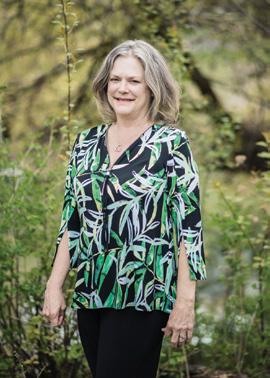
Whitefish Mountain Resort’s Ski School team of 150 instructors come from all over the world and are available to help students gain additional experience regardless of their skill level. Read Callie Reagan’s story about Magdelen (Mags) Shale, the Snow sports & Summer Activities Director, and what’s available on the mountain this win ter on page 16 in the Business & Health side.

“Listen with your mouth closed and your heart open.”
– Christine Toda



Have you ever met someone who seemed so comfortable in their own skin, that you felt comfortable, too? Karla is such a person. That must be why customers feel so relaxed and comfortable in her store, Monaco, an undiscovered gem in Columbia Falls.
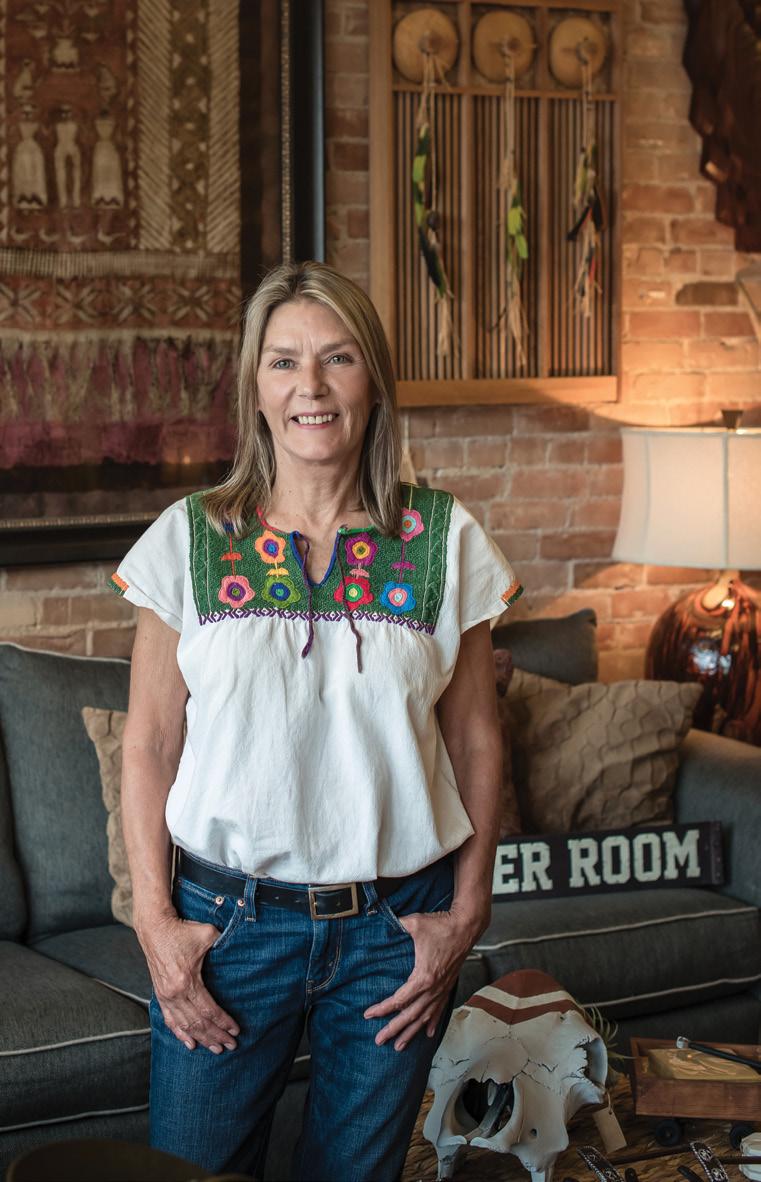
Owned and operated by Karla Piscopo, Monaco is an eclectic collection of home furnishings, home décor, and a treasury of SO many things you didn’t know you needed. Karla has an easy way about her that makes people want to share things . . . not just what they are looking for in her store, but how it will fill a niche in their life. It’s almost uncanny.
Monaco is located on Nucleus Avenue next door to the Gunsight Saloon and has been open in the historic building that was originally a bank, and a series of antique and clothing stores before Monaco took it over a couple of years ago. The store takes its name from the original moniker given to the settlement that eventually came to be known as Columbia Falls.
The shop was doing a brisk business for a week day afternoon on the day I stopped there. While I was there a handful of ladies stopped in af ter lunching across the street, a young woman dropped by and found a western hat she needed, and a mother from Eureka - who is in the middle of a major house construction project - came in looking for just the right furniture pieces to have when the building is all done. Karla had met and remembered each customer previously, and she was able to direct them to items that she instinc tively knew might be perfect for them.
Monaco is full of items that are collectible, high end, and gently used, and Karla buys her inven tory outright, not on consignment, so that she can control the cost and offer them to her cus tomers at very affordable prices. She sometimes buys from people who have just moved here and somehow found that their furniture or art piec es don’t seem to fit into their new living space.
They may come in to sell her something and end up also finding something that does fit their new space and lifestyle.
“I buy nothing online – everything in my store I bought from people right here in the valley,” says Karla. “I have had customers compliment me on the fair prices I have on stuff in here.” She does her research for sure, but she just seems to have a knack for knowing what people might want to pay for things and prices them accordingly.
She was a massage therapist for 23 years when she moved here to be closer to her daughter and granddaughters. She worked for some private individuals do ing some concierge/home management/ house & pet sitting type work. She loved the people she was working for, but while doing this, she discovered that she was good at helping her customers find items for their homes and sell items they didn’t need. A friend encouraged her to branch out and start her own business.
“I wasn’t really looking for this place, but in January 2020, the planets lined up, and my friend told me of a space available in Co lumbia Falls. I came and looked at it, imme diately rented it, and worked like crazy to fill it with beautiful stuff to open the doors in April.”
Karla grew up in Colorado with her parents, brother, and two sisters. Her whole fam ily has always had a love for home décor, creating and beautifying things. Her mom was actually named the Martha Stewart of Denver by the Denver Post ! Even as stayat-home mom, her mother also worked for the advertising department at Sears & Roe buck. She remembers her mom painstak ingly cutting out photographs for the Sun day paper and gluing them strategically on special paper to go to press.
Karla has two daughters, and she loves be ing close to the oldest, Morgan, who works in Glacier Park, and also the bonus that her granddaughters (ages 5 & 7) get to come in and help her set up displays and catalog
the stuff in the store. They love mak ing the tags and one of the girls cata loged a pair of vintage doll shoes, very carefully and neatly hand writing “tiny shoes” on the tag – just the sweet est thing! Karla’s younger daughter, Whitney, who studied in Big Sur, is massage therapist in Los Angeles.
It seems she is always working, and that is truly one of her joys. But in her spare time, she loves to spend time visiting with family and friends, going to one of our many statewide hot springs, hiking, generally just be ing outdoors. When she thinks of her favorite days, they are always in the summer.
How did she come to be so good at what she does? She has traveled all over, and much of her expertise comes from the traveling she has done and the appreciation for all kinds of styles. Perhaps the fact that she is a people person has had a lot to do with her success at Monaco. The customers that stopped by in the short time I was there did not just come in the store to shop – they seemed to enjoy visiting while they were there, men too!
The store’s collection of unique items also lends itself to the masculine shopper. “Men have their own sense of style and taste,” says Karla, “we worked hard to create a place where men feel comfortable coming in to buy stuff for their places, too.”

The store currently carries a wide and varied selection of home furnishings and design styles - each artfully ar ranged into delightful vignettes. The layout is so well done and so homey that one might think they have just walked into someone’s home for a visit. The at mosphere of the store and Karla’s easy personality make for a relaxed and com fortable place to be. She has had people stop in after shopping at the nearby bookstore and they might just sit down and read for a spell. It is just that kind of place…you simply must go there and experience it for yourself!
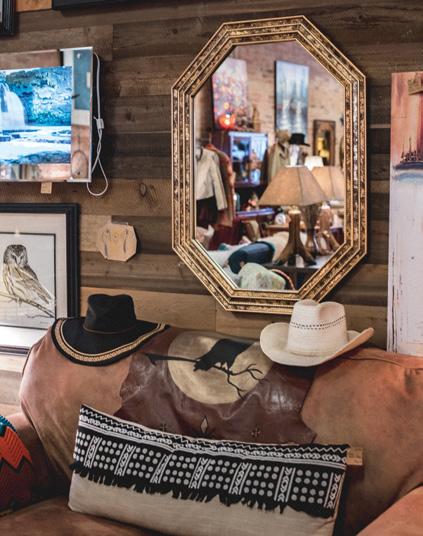
The address is 606 Nucleus Avenue, Co lumbia Falls, MT. Monaco is open 11 am – 6 pm Tuesdays through Saturdays and by appointment. Call (406) 283-5047 or find them at https://www.facebook. com/monaco.furniture.mt. But really, just go there; you’ll be glad you did.
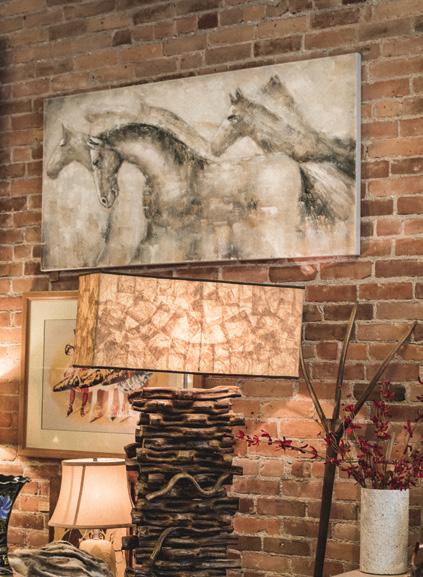
“I buy nothing online – everything in my store I bought from people right here in the valley,” says Karla. “I have had customers compliment me on the fair prices I have on stuff in here.”



The end of the year really is the most won derful time of the year. It’s festive and col orful, with get-togethers and lots of family and friends. It’s time spent together and involves warm food, cozy blankets, and lots of lights.
The end of the year for a lot of us involves being a host. Thanksgiving and Christmas are two holidays that typi cally involve a holiday dinner and the ability to adapt your everyday space to accommodate a larger group of people for holiday gatherings is often a priority for people when designing their spaces. We set our spaces up for everyday use and then expand it on the occasions when we need to.
Expandable dining tables with leaf extensions are an ex cellent way to add a few more seats to your dinner table. You can add a few more chairs or swap some out for a bench. You can also use other areas to create dining op tions such as a bar, sofa table with some stools or creating a fun kid’s dining area around the coffee table.

Whether you are hosting a formal event or a casual gathering, themed centerpieces can be added to the center to enhance a specific style. Setting the table with dinnerware, glasses, cloth napkins with unique napkin rings are fun way to add a bit of design style to your event.
Hosting for dining events doesn't always require the use of the dining table. It can be a gathering with ap petizers and cocktails. In those cases, the design of your bar or kitchen counter may be more important than your dining table. Having a bar with lots of storage and a nice display countertop is always a bonus for gather ings like that and can easily be the center of design for the event. Additional serving spaces like sideboards, buffet cabinets, and sofa tables can be converted to hold drinks, appetizers, party decorations or favors. Decora tive bowls, glasses and serving trays can be used in these areas to add function and style.
In Montana, the season is typically cold and snowy for the holidays. This means that we are pulling out our large coats, scarves, hats, and boots and needing to adjust the storage space in our entries. Clear off the bench, and add a console to store your hats, and scarves so your space remains clean and welcoming. Add a durable front door mat and entry rug. A hall tree is sometimes the perfect solution because you can get maximized function out of just one piece- it is storage, bench, hooks, and a mirror. Adding seasonal accessories to the entry or front porch enhances the design and can create a welcoming atmosphere.
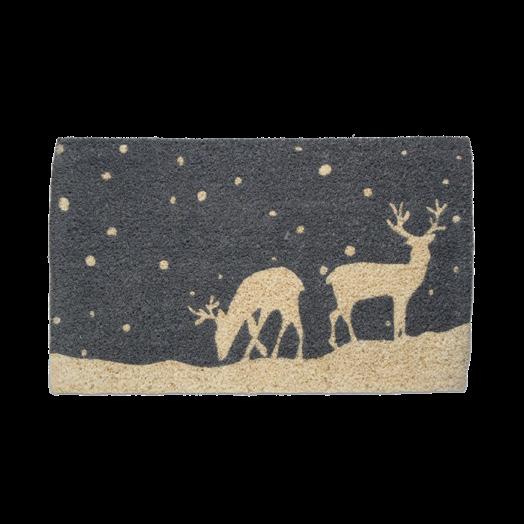






It is almost inevitable that we will have overnight guests at this time of year. Having enough sleeping space when guests are over can be tricky but there are a few additional options if simply adding an air mattress to the living room floor isn’t quite what you have in mind. Sleepers are an excellent furniture piece and can comfortably accommodate guests. Sleepers have evolved very much over the years and are now available in both stylish and comfortable options. Yes, we said comfortable. We offer several sleeper sofa manufac turers that are commercially rated, offer many frames and mattress styles, sizes, and configuration options. Our top products don’t even have that uncomfortable bar and springs under the mattress that you may have heard of. Sleepers can be added to a living room in the sofa or sectional OR add a sleeper loveseat or chair to an office so a more private room can be converted for guest sleeping. You don’t have to give up design style or comfort when adding a sleeper these days. When converting a space to casual sleeping, we can also look at a new popular style of living room seating such as a modular deep-seated sectional. Many sofa frames are available that are overly deep, comfortable, and moveable so pieces can be bunched up together to create a temporary bed. Remove the cushions on those deep-seated sofas and you practically have a twin-size bed.
Whether you are planning a gathering or not this holiday season there are always simple ways to add design style to your space. We talk a lot about layering your spaces and creat ing eye movement with those layers. If you have a holiday theme, play that theme up with specific items, if you don’t have a theme, just use the season as your guide. Think cozy, layers, and soft textures. Use pillows and throws like faux furs, rich leathers, velvets, plaid flannels, patterned wool blankets, and knits. Change your floral arrangement and botanical fillers to something more season appropriate, and add holiday-themed coffee table books, scented candles and soaps, holiday string lights, and tabletop accessories.
All your design needs can be found at Wrights Furniture in Whitefish. If you need a little help with designing your space, we offer complimentary personalized design services. You can’t go wrong when you are shopping at Wright’s. We wish you a happy and safe holiday season.
urniture is open 7 days a week, offering complimentary design services with free local delivery and install. urniture showroom in Whitefish or learn more at wrightsfurniturestore.net
Whether you are planning a gathering or not this holiday season there are always simple ways to add


 By Adriena Daunt, Daunt Designs
By Adriena Daunt, Daunt Designs
This month, Adriena answers your questions about achieving that per fect holiday décor. Read on for tips on how to make your home a warm and inviting haven when celebrating the holidays with family and friends.
What color palette should I use for holiday décor?
It’s easy to think we have to stick with red and green for the holidays, but there are no such rules. Santa and his elves won’t put a lump of coal in your stocking for using blue, white, or even orange!
Feel free to use your favorite color or pattern as an anchor when planning your holiday décor. The key is to keep it consistent and not to use too many colors or patterns that fight with each other. Love leopard-print? Go for it! Just don’t pair it with plaid.

Allow me to introduce you to one of the design er’s most useful resources – the color wheel. Us ing the color wheel as a reference helps to know which colors will work together in your décor scheme. The easiest color schemes for begin ners to use are complementary, analogous, or monochromatic.
Complementary colors are opposite each other on the color wheel, and in fact the traditional col ors of red and green are complementary, which
Another option for a complementary holiday theme could be a warm rust plaid with pops of navy blue. Be careful with colder colors like blues and greens – it often works well to pair these with warm-toned natural materials like wood and brass.
Analogous colors are next to each other on the color wheel and create a calming effect – an ex ample for the holidays could be a spectrum of violets through to reds and oranges. Monochro matic themes use only one color on the wheel in a variety of different shades or paired with neutrals – imagine a holiday palette of baby blue with cobalt and navy or a citrusy bright yellow and white.
As with any design, good holiday decorating starts with intention. Just as you can use the col or wheel to plan your holiday color palette, take into consideration the architectural style, period, and scale of your home when you plan your dé cor. Think about what feeling you want to create – formal, cozy, elegant or inviting to name a few.

If your home is a craftsman bungalow, you could use a William Morris arts and crafts floral fabric as the basis for your décor. Or if it’s a steel and glass contemporary with soaring ceilings, you can play with scale and create a sculptural hol iday-inspired installation with garlands or glass balls. Have an overall style in mind and stick to it, whether it’s traditional, eclectic or farmhouse.
Think about the areas you want to decorate and how much time and effort you want to put into it. If going all-out and decorating every room is too overwhelming, focus on the main living spaces with a couple of key areas in each - such as the fireplace or entryway. In addition to holiday dé cor such as garlands, wreaths and ornaments, you can swap out soft furnishings such as throw pillows and bedding, plus add candles and plants. Don’t be afraid to overdo it – Christmaximalism is a thing!
Try to appeal to all five senses when decorating for the holidays. Add some clove or peppermint essential oils or candles to create that delicious holiday smell. And think about using tactile ma terials like fur and wool as part of your theme. You can also mix hard and soft textures such as shiny glass and metals with sinuous ribbon or fabric.
Again, think about the style and lines of your home. Walk away from your curb and look at your house from a distance – what are the most obvious architectural features? Try to accentuate those with your lighting.
Keep the design principle of repetition in mind here – usually a home will already have repeat ing architectural features such as roof peaks or porches. Highlight these features consistently with the same color and style of lights and com plement with a secondary lighting color or exte rior décor such as wreaths in evenly spaced loca tions.
mum diameter and height of your perfect tree. Don’t forget to allow for clearance around the tree if it is next to a heavily trafficked walkway –a minimum of 3 feet is recommended for people to be able to walk past without dislodging orna ments from the tree.
You can also move furniture to make space for your tree if you need. Accent chairs are often a similar size to the footprint of a tree, and they can be moved into a bedroom or office to create space. If you have a tight space for your tree, you can also trim a few branches off the back so it can fit closer against the wall and repurpose those cut branches into wreaths.


Don’t have time to do your own holiday decorating? There are several home décor stores in the Flathead that will do it for you. Call the below businesses to find out more.
Honey Home & Design, 406-890-2900
A modern farmhouse with lots of gables and dor mers might look too busy with strings of lights around every roof peak, so choose a couple of the larger peaks for icicle lights while keeping the lines clean around the rest of the home. Asymme try can work, but it must be intentional.
We’re so lucky here in Montana to be able to cut our own trees. But how many times has that per fect tree not looked so perfect when you got it home? Maybe you had to squash it into a corner or it was too tall for your ceiling.
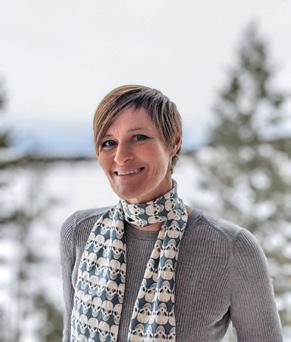
The old adage of “measure twice, cut once” ap plies here. Decide where your tree is going to go before you cut it and measure the space both horizontally and vertically so you know the maxi
Lemontree Montana, 406-300-3136
Daunt Designs offers interior design services to the Flathead Valley, including new construction, remodeling, furnishing and decorating. Learn more on dauntdesigns.com.
How do I decorate in keeping with the style of my home?By Bogle Vineyards - www.boglewinery.com
This holiday season, let Bogle Vineyards put the extra sparkle on your table with these two delicious appetizers.
First up is a festive pull-apart bread baked with Brie, cranberry sauce, sage, and bacon. It’s an explosion of holiday flavors in every bite. We suggest pairing this baked goodness with Bogle’s Chenin Blanc.

Our second appetizer is the perfect starter for a New Year’s Eve celebration. This quick and easy appetizer can be prepared with store-bought spinach and artichoke dip. We suggest pairing this with our Blanc de Blancs.
Both our Chenin Blanc and Blanc de Blancs are available in our tasting room or e-store. You can visit our online store by scanning the QR code at the end of this article or through our website www.boglewinery.com.
1. Preheat oven to 400˚F. Stir together cranberry sauce, melted butter, sage, salt and pepper; set aside.
2. Using a sharp bread knife, cut crosshatch pattern into bread by slicing at 1-inch intervals in both directions, without slicing all the way through to the bottom.
3. Brush top of bread and inside crosshatches with cranberry mixture.
4. Stuff Brie and bacon into crosshatches. Wrap bread in foil; place on a parchment paper-lined baking sheet.
5. Bake for 18 to 20 minutes or until cheese melts and bread is heated through and toasty. Let stand for 5 minutes. Sprinkle with parsley.





In November 1930, Chicago was struck hard by the stock market crash and the subsequent great depression that followed. Over 75,000 Chica goans were out of work and out of luck.
A week later, the Chicago Tribune reported that a mysterious benefactor had rented a storefront. This mysterious benefactor had opened the first of its kind, a soup kitchen at 935 South State Street. The benefactor was none other than the king of gambling, booze, and prostitutes– Al Capone. Al served breakfast, lunch, and dinner to an average of 2,200 people every day.

A Capone associate was quoted in a Chicago newspaper saying “He couldn't stand to see those poor devils starving, and nobody seemed to be doing much, so the big boy decided to do it himself.” The Capone soup kitchen hired women in white aprons to serve coffee and sweet rolls for breakfast, soup and bread for lunch, and soup, coffee, and bread for dinner. Second helpings were never denied to anyone. No questions were asked, no one had to degrade themselves to prove they had the need.
Thanksgiving, in 1930 was one of the hardest ever recorded in United States his tory. Al stepped up to provide holiday helpings for 5,000 starving Chicagoans. Ca pone had planned to serve a traditional Thanksgiving meal to the jobless. How ever, when he learned a load of a thousand turkeys had been heisted, he quickly changed his mind. Afraid he would be blamed for the caper he made a menu change to beef stew.
3 stalks of celery
1 diced large yellow onion
5 cloves minced garlic
6 Tbsp olive oil, divided in half
2 1/2 lbs chuck roast or rump roast, cut into 1-inch pieces trimmed of fat
1/2 cup flour
salt and black pepper
4 cups beef broth
1 Tbsp red wine vinegar
2 (15 oz) cans of diced tomatoes
1 tsp dried oregano
1 tsp dried thyme
1 tsp dried crushed rosemary
1/2 tsp dried marjoram
3 bay leaves
1. Heat two Tbsp olive oil in a large enam eled cast iron pot over medium-high heat. Once hot add celery and onion and saute for four minutes. Add garlic and saute one minute longer. Pour mixture into a bowl and set aside.
2. Place beef in a large resealable bag, add flour, and season with salt and pep per (about 3 tsp salt and 3 tsp pepper). Seal bag and toss well to coat beef in flour evenly.
3. Return pot to medium-high heat, and add remaining olive oil. Once the oil is hot add the beef and cook occasionally tossing until the beef has browned and stick ing to the bottom of the pan.
4. Transfer browned beef to crock pot
5. Add one cup of broth into the pan and
8 oz cremini thick sliced mushrooms
4 carrots, chopped (2 cups)
4 medium-sized Russet potatoes, diced into 1-inch pieces
3 Tbsp chopped fresh basil
3 Tbsp chopped fresh parsley
Parmesan for serving
then add red wine vinegar and beef and cook, frequently stirring while scraping the bottom of the pan to loosen browned bits on the bottom.

6. Add remaining 3 cups beef broth, diced tomatoes, oregano, thyme, rosemary, marjoram, bay leaves, mushrooms, and sauteed veggie mixture. Bring mixture just to a boil, stirring frequently. Season with salt and pepper to taste.
7. Reduce heat to low, cover pot, and sim mer for 1 1/2 hours, stirring occasionally. Add potatoes and carrots and cook about 1 1/2 longer until beef and veggies are very tender.
8. Add more salt and pepper to taste.
Serve warm sprinkled with fresh basil and parsley and parmesan

Capone’s soup kitchen added to his Robin Hood reputation with a seg ment of Americans who saw him as a hero for the common man. People pointed to newspaper reports of the handouts he gave to widows and orphans. When the government deprived them of beer and alcohol during Prohibition, Capone delivered it to them. When the government failed to help them in their desperate days, the crime boss gave them food. For anyone who felt conflicted about taking charity from a gang ster, hunger trumped principles. The Bismarck Tribune noted, “a hungry man is just as glad to get soup and coffee from Al Capone as from any one else.”
Harper’s Magazines' very own Mary Borden called Capone “an ambidex trous giant who kills with one hand and feeds with the other.” She noted the irony of the lines of jobless waiting for a handout from Chicago’s most-wanted man would often stretch past the door of the city police headquarters, which held the evidence of the violent crimes carried out on Capone’s behest.
The soup kitchen served more than 350 loaves of bread, 100 dozen rolls, 50 pounds of sugar, and 30 pounds of coffee a day. The cost was over $300.00 a day ($5,320.44 in today's money). It was a sum that Capone could easily afford. Fred Ries, an associate of Al testified that the prof its from just one of his most lucrative gambling houses netted $25,000 a month ($443,369.76 in today's money).
Although the press never saw Capone in his soup kitchen, newspapers still ate up the story. The Daily Independent of Murphysboro, Illinois, expressed a distaste at the adulation bestowed upon the soup kitchen owner. “If anything were needed to make the farce of Gangland complete, it is the Al Capone soup kitchen,” it editorialized. “It would be rather terri fying to see Capone run for mayor of Chicago. We are afraid he would get a tremendous vote. It is even conceivable that he might be elected after a few more stunts like his soup kitchens.”
No amount of good deeds could save Capone from the guilty verdict handed down by a jury in November 1931. Convicted of income tax eva sion, Alcatraz, not the mayor's office, was in his future.
Let us toast Al Capone's good deeds to mankind with his favorite cocktail and Italian beef stew; and pretend his illegal activities never happened. Let us forgive all the wrongs done to us this past year… and focus on all the good, Happy Thanksgiving!


In a cocktail shaker, gently muddle the mint and simple syrup. Add remaining ingredients with ice and shake then strain into a chilled coupe glass and garnish with a mint sprig.

Ingredients
1 1/2 cups of water at room temperature
4 1/2 tablespoons of flour
1 cup of sugar
6 tablespoons of butter, diced or sliced into small pieces
2 Tablespoons vanilla
Make your own pie crust in a 9-inch pan or use store-bought frozen deep-dish pie crust
The great Depression period began in August 1929 and remained until approximately 1941. It altered the way of life for many families, because the availability of a variety of foods was diminished. Therefore, people began growing their own food, and bartering food with their neighbors. This pie recipe evolved during the depression because even de pressed folks need dessert (I totally get it). It's surprising how custardy and good it is…especially when you see the ingredients!
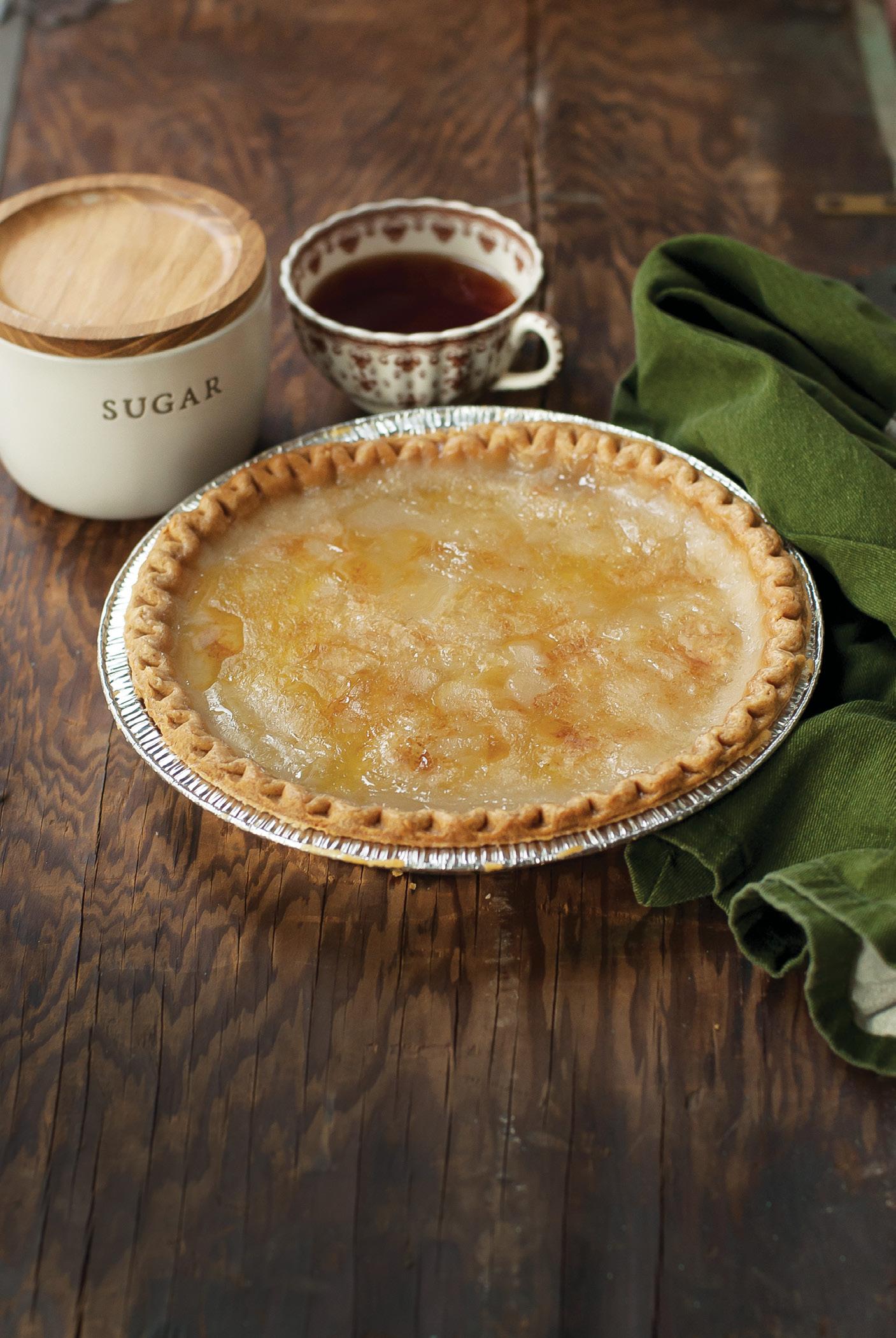
Heat your oven to 400 degrees. Make your pie crust homemade or use store-bought frozen 9-inch pie crust. The store-bought pie crust tends to hold up better when adding liquid ingredients.
In a bowl, mix sugar and flour together. Pour water into the pie crust. Sprinkle the flour and sugar mixture on top of the water (that is in the pie crust). Disperse it evenly over the whole pie, do not mix. sprinkle vanilla into the mix. Evenly distribute butter into the mixture.
Bake for 30 minutes at 400 degrees. Reduce oven heat to 375, then cook for another 30 minutes. When reducing heat, you may need to cover the crust edge with aluminum foil to protect from overcooking. Let cool and enjoy this surprising pie with your favorite fruit.
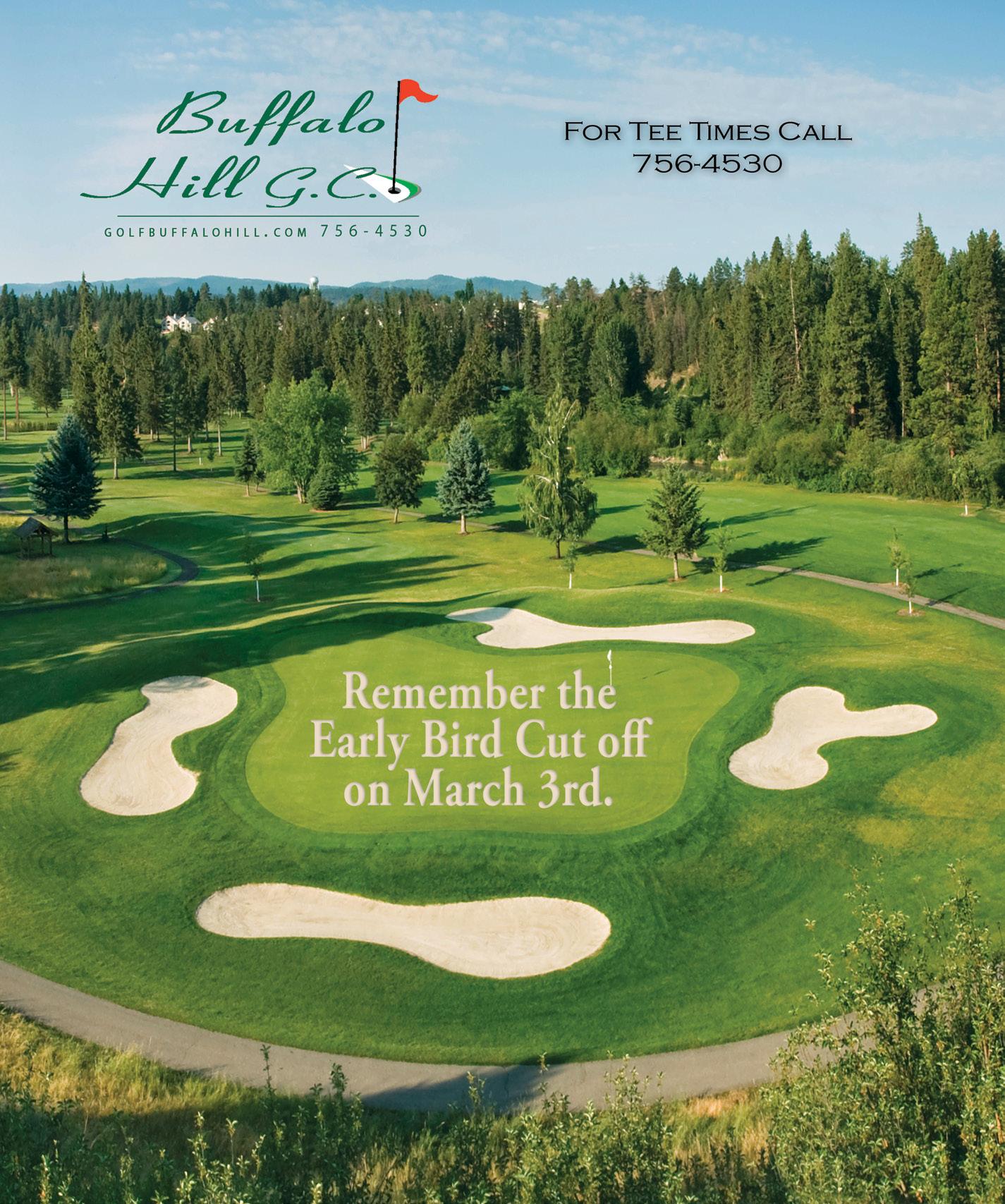





The holidays are nigh and it’s the perfect time to host a party! No time you say?
Yeah, me too……
But still, wouldn’t it be fun to spend a cou ple of hours with some friends, enjoy a few drinks, and nosh on some tasty snacks? OH! Wait a minute…. I know – Happy Hour!

Hmmm – probably going to be a bit spendy to go to a bar. I just happened to be out doing some research at some local places last week end and single cocktail prices were anywhere from $9 - $15! So hear me out, okay? Why not host a Happy Hour at home?
Time to make a trip to the Bigfork Liquor Barn to get their take on this idea. They liked it! First of all, not being a bartender, what cock tails should I serve? What wines? They sug gested a pitcher or two of one popular cocktail recipe, one or two nice bottles of wine, one sweet creamy drink, one hot drink (if desired) and one non-alcoholic beverage. We talked about a few ideas and recipes, and I settled on the following:

Whistling andy’s gin or your favorite brand gin infused with cardamom seeds
(Recipe follows)
rosemary Infused Simple Syrup (recipe also follows)
More fresh rosemary sprigs grapefruit Juice
Prosecco
Make the simple syrup by combining one cup sugar and one cup water in a saucepan. Toss in a few fresh sprigs of rosemary and simmer until sugar is dis solved. Make the cardamom infused gin by filling a mason jar with the gin and add a couple tablespoons of cardamom seeds and let stand for 24 hours. To make the cock tail: Place lots of ice in a cocktail shaker, pour in the rosemary syrup, gin, and grapefruit juice. Shake hard for about 30 seconds to make it su per frothy. Strain into a glass filled with fresh ice and a sprig of rosemary. Top with a splash of prosecco - Voila!
Fill a tall glass with ice and add a shot of Kahlua, a shot of Baileys, a shot of your favorite vodka, and top it off with soda water. Add tall straws. So good!

10 whole cloves
one bottle of red wine or hard apple cider
¾ cup brown sugar
Whole cranberries
3 cinnamon sticks
5-star anise
2 -3 oranges
Place all the ingredients except the oranges in a medium size pot. Us ing a sharp knife or peeler, skim just the orange rind of one orange (avoid cutting into the pith as much as possible as it has a bitter taste). Juice the rest of the oranges and add to the pot. Over medium heat, heat the mixture until just steaming (don’t boil to avoid losing much of the alcohol content). Simmer on low heat for 30 minutes. Toss in a few orange slices, if desired, and ladle into mugs. The whole house will smell like Christmas!

f or the wine, my Liquor Barn experts suggested a nice Malbec or Cabernet Sauvignon (red) and Pinot Noir or Gewurztraminer (white). Their store has two sommeliers on staff, and they are glad to help with the perfect pairing when you tell them your menu. They can also recommend some great everyday red, whites, and bubbles to have on hand should an occasion or wine emergency arise.
f or n on-Drinkers – make hot cocoa by warming together a mixture of milk, sugar, salt, and vanilla. One steaming, stir in some chopped chocolate squares or chocolate syrup to taste. This can be served immediately to non-drinkers. BONUS! You can make this boozy by stirring in some Peppermint Schnapps, or add a little bourbon, Fran gelico, and a splash of Irish cream. Top with toasted marshmallows.
n on-alcoholic Sparkling c ider or Kombucha are also great and look so festive in a glass.
Charcuterie boards (or festive Charcuterie cups that I was just treated to at MontaVino last week). Charcuterie boards can be purchased from nearly any local deli, but even though it may turn out to be a Pinterest fail, I want to try making my own. A fun assortment of soft & hard cheeses, savory jams, crackers, cured meats, fruits and nuts could look amazing on my Montana shaped wood board. Couldn’t it? Yes, I think it might.
We can’t have a holiday party without tiny pigs in blankets with dip ping sauce. Crescent rolls and little smokies are my friends.
Ditto bacon-wrapped almost anything. Even though I don’t like spicy stuff, bacon-wrapped jalapeños are always a hit.
A huge bowl of popcorn, because . . . well – popcorn!
Lastly, some chocolatey things - chocolate dipped butter cookies, chocolate truffles, toffees, and biscotti.
We’re pretty laid back around here, so disposable appetizer plates, forks, napkins, and cups, along with a handful of fresh holiday flowers to plop into a mason jar should complete the party supplies.
Now to pick a day and time. I suppose it could be after work dur ing traditional happy hour but who says it has to be from 4-6 pm? How about Sunday Brunch Happy Hour, a Neighborhood Happy Hour Saturday Mid-Afternoon. So excited – can’t wait to kick back with family, neighbors, and friends. Who wants to pop over for Happy Hour at my place?


 Written by Paulina Crum, marketing and PubliC relations assoCiate
Written by Paulina Crum, marketing and PubliC relations assoCiate
Our community aspired for a high-end performance venue in the Flathead Valley, as well as a designated performance home for the established Glacier Sym phony Orchestra and Chorale. At our 40th season, Glacier Symphony Orchestra and Chorale celebrates the unveiling of McClaren Hall at Wachholz College Center. Not only are we looking forward to playing for 1,000 audience members each performance, but for the acoustically exceptional experience that will further highlight the rich talent of our orchestra and chorale members as well as our featured guest artists. Glacier Symphony sees this milestone as a larger sym bol of progress and partnership, represented in both building and sustaining this type of venue, within our community. As a reflection of this community evolu tion, your symphony presents its widest variety of season performances yet in its 2022-2023 Symphonic Spectacular, with each event incorporating intentional celebration of the surrounding area.

Starting with our opening weekend, a complimentary champagne reception and photo booth extravaganza will welcome all attendees arriving at each of the November 19th and 20th performances to thank everyone that made this exciting new chapter of arts and entertainment pos sible. Glacier Symphony looks forward to seeing different members of our community raise a glass while viewing the new hall, capturing moments at our photo booth and listening to beautiful music our talented orchestra, cho rale and soloists have spent endless hours perfecting.
The night’s performance will be an especially fitting pair ing, as Beethoven’s 9th Symphony and its “Ode to Joy” finale is beloved by many for its deeper meaning about community and togetherness. This piece of music has be come a symbol for the joyful connection between all hu manity. Beethoven’s 9th was inspired by Friedrich Schil ler’s poem, “Ode to Joy” (1785), which spoke of a new age that would no longer divide and “all men shall become brothers.” Our opening concert will celebrate this unity, as we all share in a new era of shaping a positive future for our valley.

a s a member of the f lathead Valley for 40 years, Glacier Symphony knows the spirit of comradery is what makes our area so special and beloved.
Glacier Symphony wishes to play a key role in maintaining the sense of community in the valley and at this new performance hall. Not only do we wish to lead this charge in the local art and performance circle, but in all circles of northwest Mon tana’s community tapestry. We are actively creating initiatives to welcome all to our concerts and support widespread art and music performance exposure in the Flat head Valley.
Glacier Symphony and Glacier Bank are fund ing tickets for local music students to attend our opening weekend for Beethoven’s 9th: “Ode to Joy.” We are working to extend this program beyond our first performance and to a broader range of students. We are looking for interested partners for extending this program.
Bringing music education and introduction to young minds is central to Glacier Symphony’s mission and identity. We continue to expand our Youth Music Education program, which supports music education in our area and provides chil dren with a creative outlet, cognitive development activity and lasting skills that open doors in the fu ture. The symphony also feels especially lucky to have many music educators in its orchestra and chorale. Not only do they dedicate their time to ex tensively rehearsing for performances, but these educators are dedicated to passing music on to the next generation of talent in our valley.
The next concert in the Symphonic Spectacular season is Handel’s Messiah, a long-standing tra

dition within Glacier Symphony performances. Previously, they performed this sacred Christmas orchestra and chorale piece at local churches but will now perform in the large and state-of-the-art facility. For the December 3rd and 4th Handel’s Messiah performances, Glacier Symphony is extending a special offer to congregations and community service organizations. Faith and com munity organizations that book tickets for 15 or more people will have the option to be seated together if reservations are placed early. Fur thermore, please be sure to inform the box office when booking and 10 percent of your group ticket purchase will be donated back to your church or community organization. Glacier Symphony is grateful for the churches that have hosted our performances in past years, and we wish to return that generosity to our local faith and community organizations.
performance of the season, Glacier Symphony and San Diego Ballet Company are partnering on a fully staged production of the Nutcracker and have welcomed in more than 60 young lo cal dancers from ballet studios across the valley to perform in this Christmas classic. This highcaliber performance experience will not only be a fond memory for many of the local dancers and their families but propels these local ballerinas to new levels of opportunity in their performance future. Marisa Roth, Owner and Director of the lo cal Northwest Ballet School, has been impressed with the passionate dancers, ages 6 and up, and their dedicated parents. "It's going to be such a fun show!" she smiles, "These kids have been such an inspiration to work with." Regarding his first ballet scene experience in the Flathead Valley, San Diego Ballet Company's Executive Director Matt Carney said, "I'm impressed with the talent we saw by all that auditioned. It's heartwarming to see so many different studios from the entire region be represented. We are really looking for ward to the opportunity to collaborate with local musicians and dancers and are excited to convene the community."

Throughout this Symphonic Spectacular season, Glacier Symphony will weave the communitycentered, interconnected feel into every perfor mance at the new hall. As a member of the Flat head Valley for 40 years, Glacier Symphony knows the spirit of comradery is what makes our area so special and beloved. The fabulous scenery and your exceptionally talented orchestra and chorale performances add to the valley’s sparkle, too.
In addition to developing young music enthusi asts, Glacier Symphony wishes to support our artists and performers of tomorrow. In our third
To learn more about the Glacier Symphony Or chestra and Chorale, visit www.gscmusic.org.



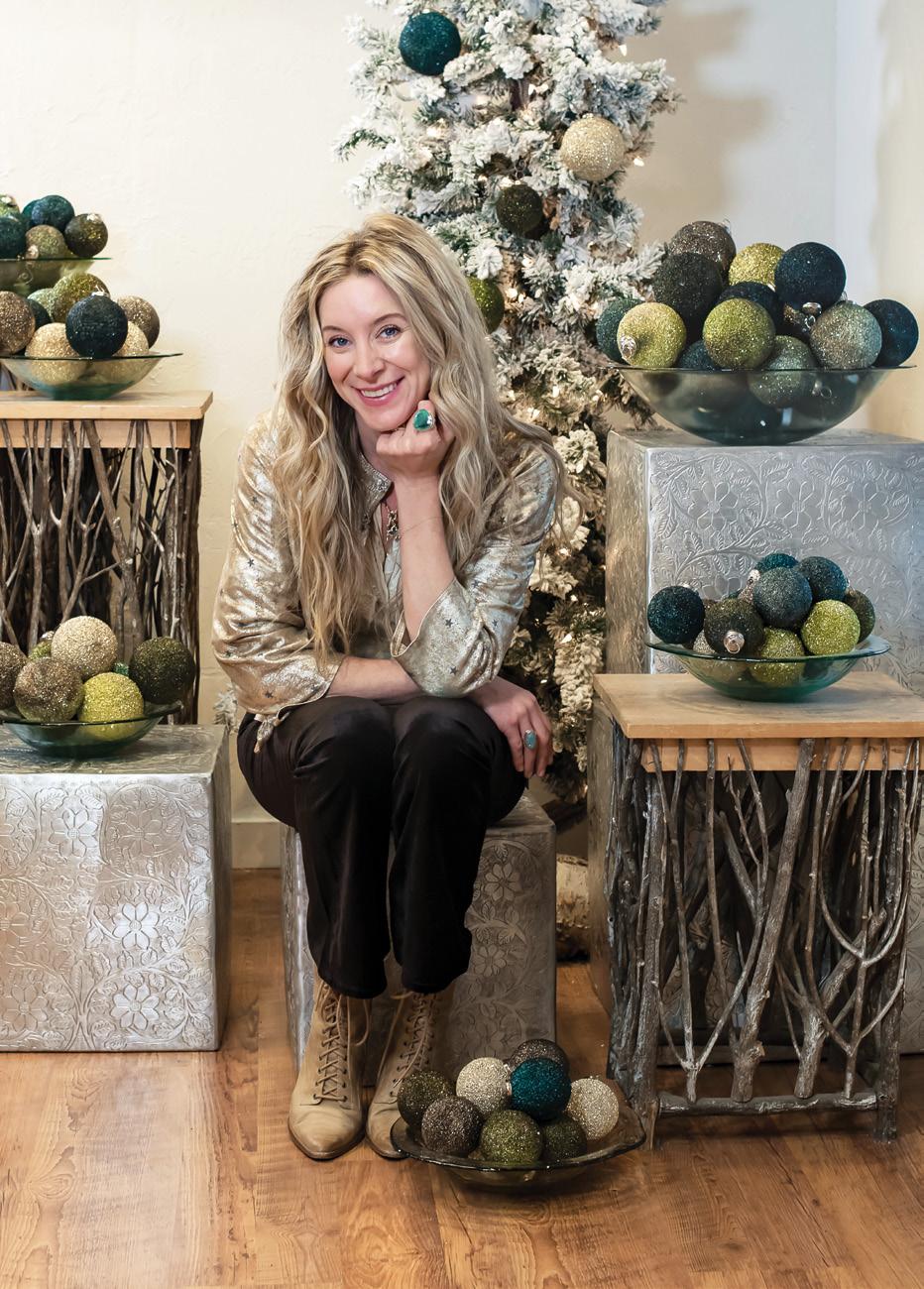




Kyle: I was born and raised in Wyoming and moved to Montana in 2012. I reside in Kalispell, MT and own a company specializing in structural grade construction.
Andrea: I was born and raised in the Flat head Valley. I went to college in Bozeman, MT where I met Kyle. We moved back to Kalispell in 2020 to be closer to the mountains and lakes. We spend most of our time out explor ing the woods with our two dogs.





Andrea: What is the trait that you most admire in Kyle?
There are so many great qualities that Kyle has. My favorite is that he is a very patient and motivated man.
Kyle: When did you realize you wanted to get married to Andrea?
It’s hard to put an exact date on when I wanted to marry Andrea but I was pretty confident she was the one after so many adventures that ended both good and bad. She showed me not only that she could endure the frustrations that I give her but also the ones that we would have to endure together.
Why did you choose the venue you did to getting married?

We got engaged in January and wanted to get married in August. We chose Triple B Ranch because it was in the middle of the valley, GORGEOUS, and had a weekend available in August this year.

Andrea: What did you enjoy most during your wedding day?
All of the love that was there. It was one full day of nothing but love and bringing family and friends together.
Kyle: What is your favorite activity to do as a couple?
Andrea and I are both passionate about the outdoors. We find so much joy, peace, and understanding whenever we are on the mountains, lakes, or riv ers together. We spend a lot of our time fishing, camping, hunting, and hiking.


Photography: Hope Kauffman Photography
Venue: Triple B Ranch
Rentals: The Party Store
Caterer: Great Northwest Catering - BEST FOOD EVER
Cake/Dessert: Miss Patty Cakes
Music: Destination DJ for reception and Cindy Weaver on the harp for the ceremony
Dress: Cloud 9 Bridal in Coeur d’Alene, ID
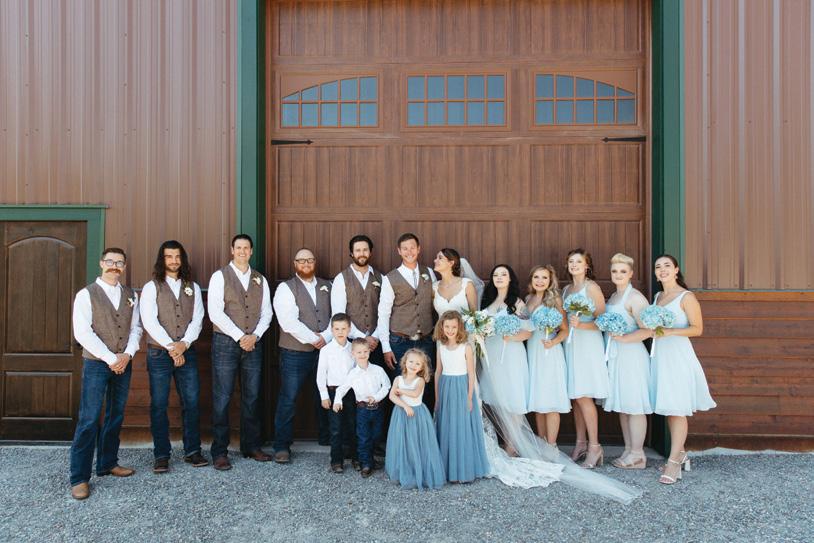
Tuxes/Suits: Boot Barn
Rings: McGough and Co.
Hair: Michelle at Red Union Salon
Makeup: Alex at Orenda Beauty
Flowers: Melissa at Farm to Market Floral
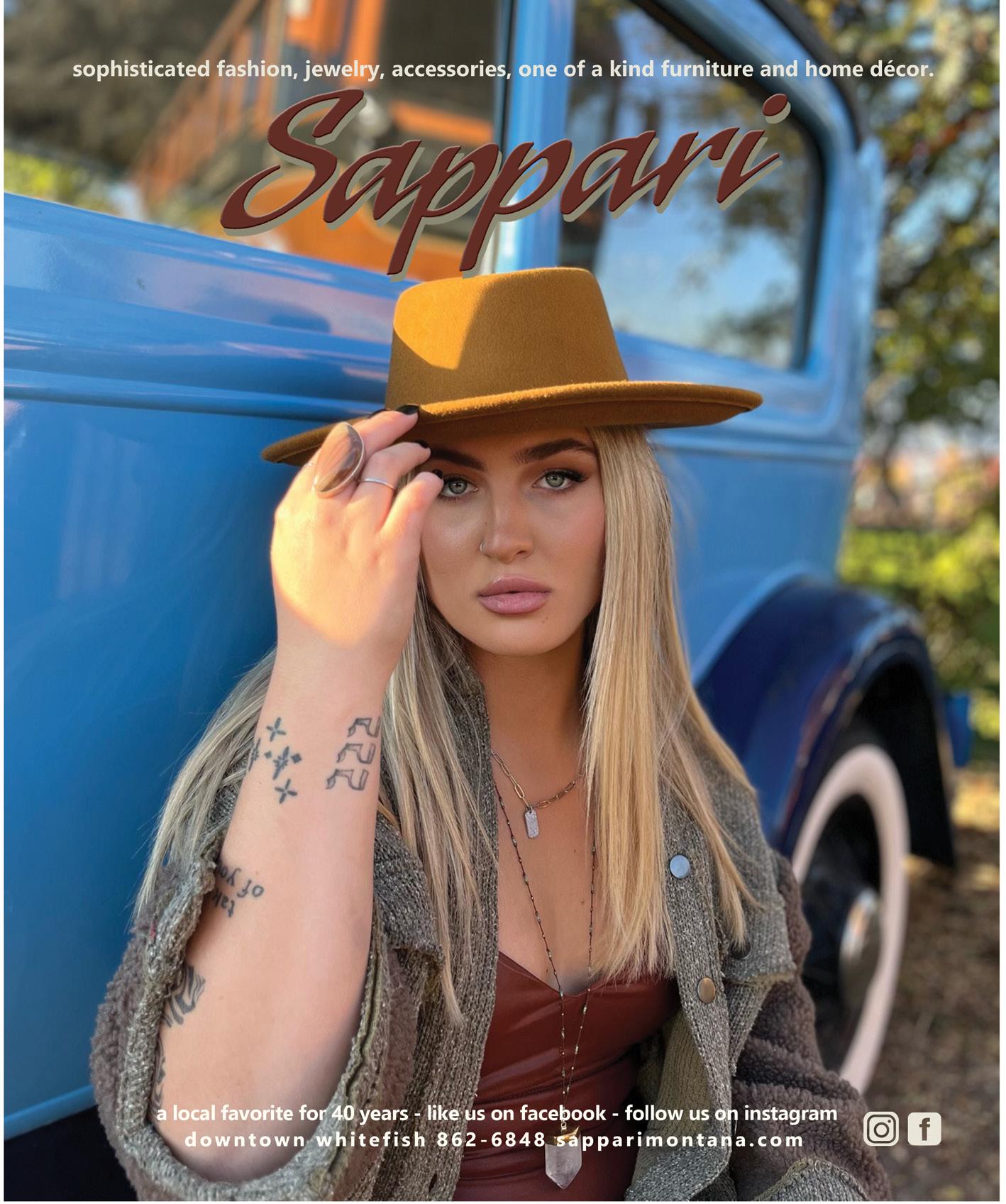

TheLodge at Whitefish Lake provided the perfect balance of stunning views in every direction, along with a variety of well-appointed accommodations, excellent dining, and luxurious amenities.
Sophie and Blake first met at the Nékter Juice Bar in Scottsdale, AZ, in 2015. It was a typical sunny day in the desert, so Sophie decided to get herself a refreshing smoothie. Blake was working behind the counter when Sophie walked in and their eyes met, igniting a ro mance that changed their lives.
Five years later, while experiencing a romantic dog sled ride through the snowy hills of Montana, Blake bent down on one knee before Sophie and proposed they marry. Anyone that has met Sophie knows she’s a lover of

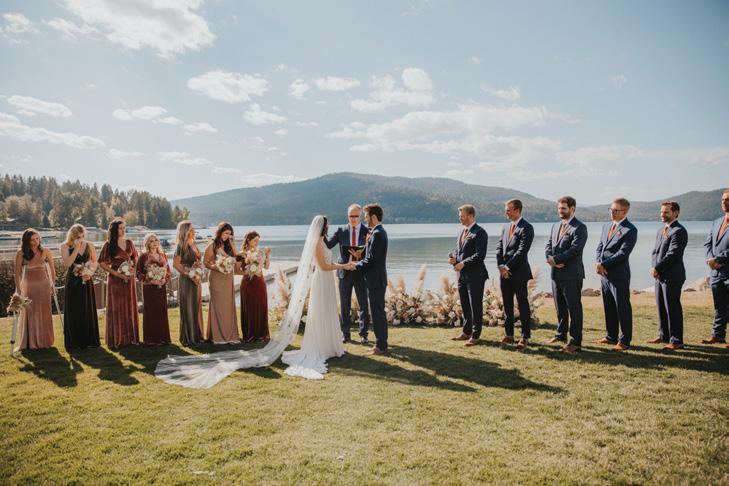



all animals, so when she immediately replied with an emphatic “YES!” it was serendipitous and perfect to have the sled dogs joyously howling around them.
The couple moved to Whitefish in 2018 and quickly fell in love with the quaint mountain town. Of course, they want ed their family and friends to have the opportunity to experience their beloved community and explore the beauty of Montana. That is one of the many reasons they picked The Lodge at Whitefish Lake to host their wedding. It provided the perfect balance of stun ning views in every direction, along with a variety of well-appointed ac commodations, excellent dining, and luxurious amenities for their friends and family.

Since they had guests traveling from near and far, Sophie & Blake chose a fall
date to avoid the peak summer season and allow guests better access to Glacier National Park and the area’s activities and services. Realizing that wood boat cruises on Whitefish Lake are available only thru mid-September, the couple opted to do a pre-wedding dress-up date and photo shoot to capture wed ding images aboard the Lodge’s Laurie Jo Windsor Craft Day Cruiser. Some of their favorite photos were taken on this classic wooden cruising boat as they sailed around Whitefish Lake with the sun setting behind them.



On September 24th, 2022, Sophie’s dream wedding became a reality when surrounded by loved ones, she walked down the grassy aisle on the waterfront of The Lodge at Whitefish Lake and ex changed vows with Blake. May they live happily ever after!
To learn more visit lodgeatwhitefishlake.com.
Sophie & Blake chose a fall date to avoid the peak summer season and allow guests better access to Glacier National Park and the area’s activities and services.

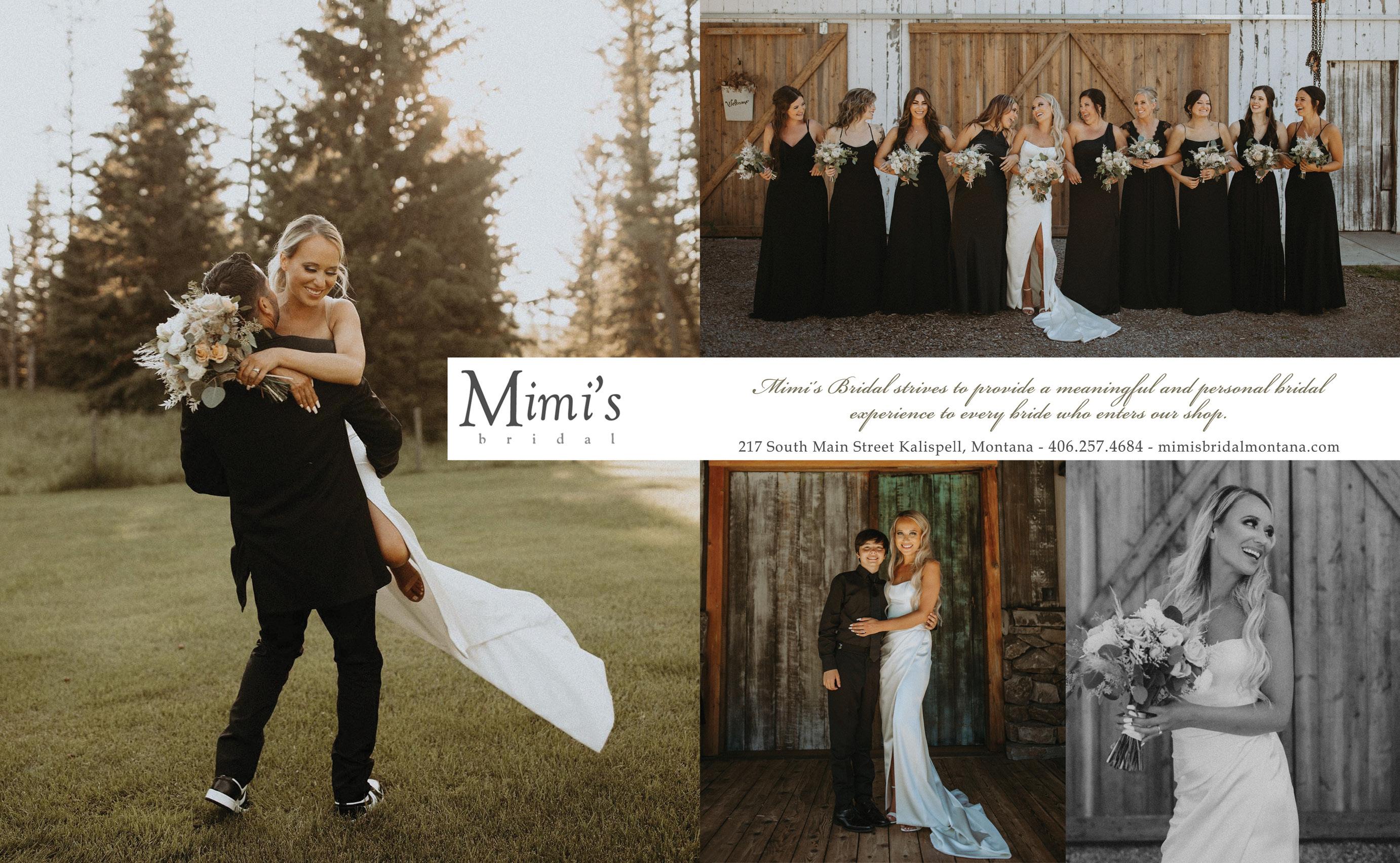

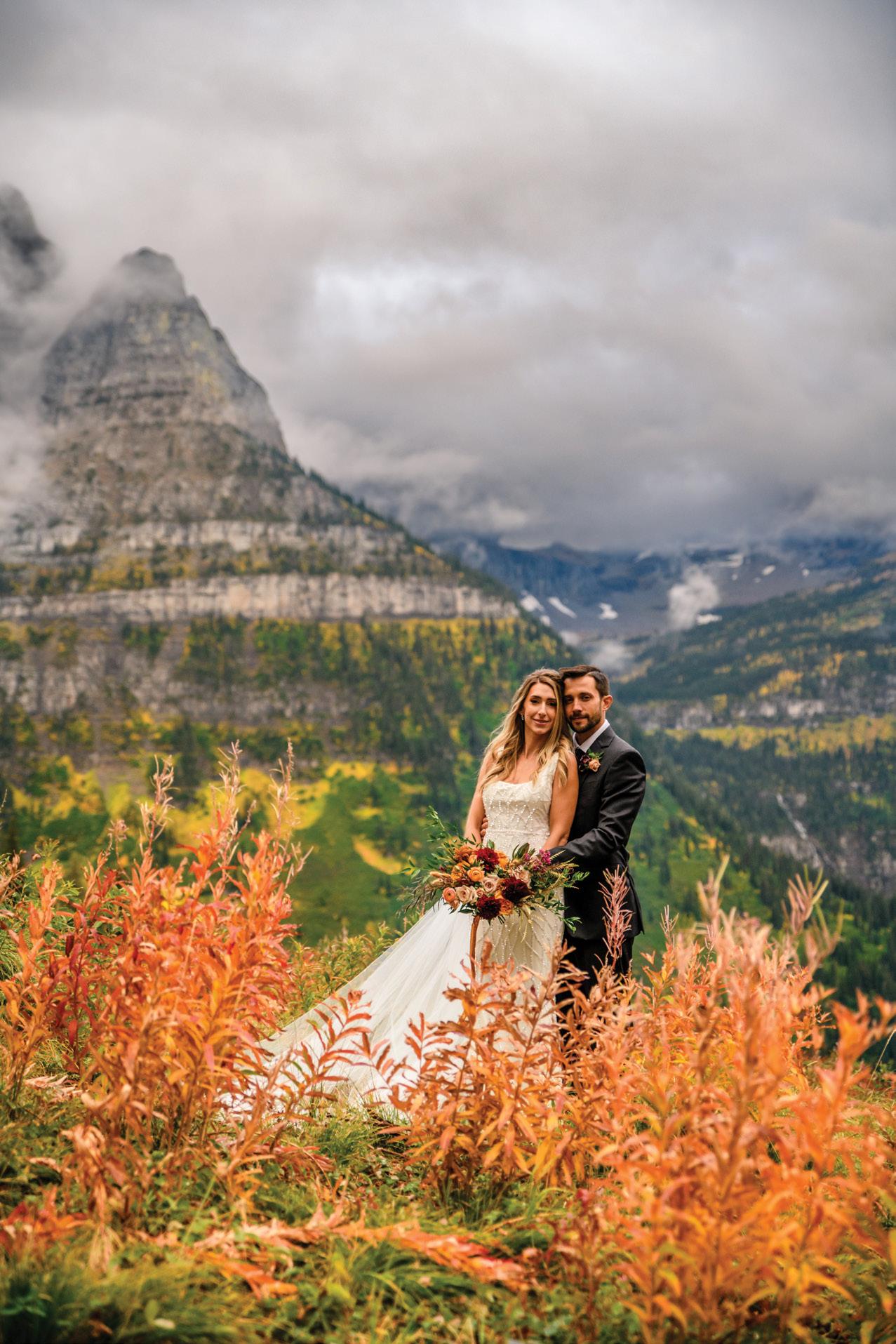

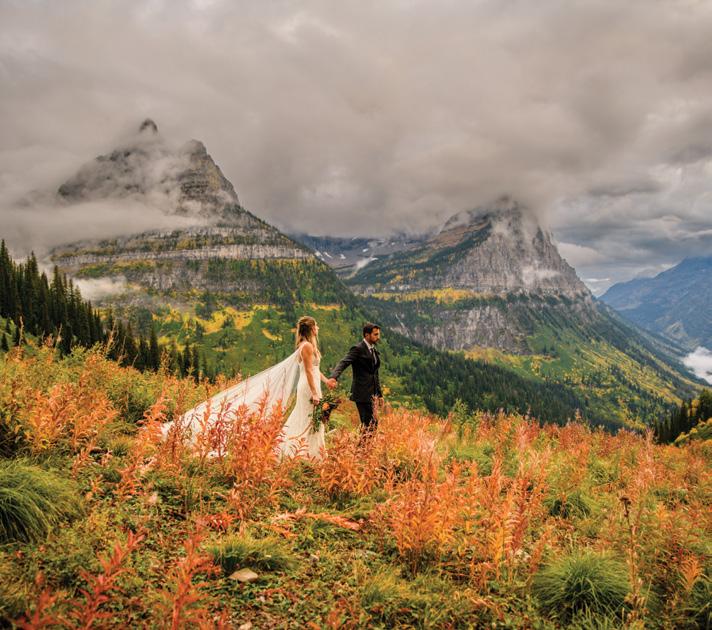

We are both from, and still currently reside in Connecticut. Adam D’Amato has his own landscaping business and Stacie Carroll works in supply chain in the aerospace industry. We have a house with endless home improvement projects, a dog, and a cat. We both love outdoor activities (hiking, mountain biking, canoeing, etc.) and pushing ourselves physically. In our down time we enjoy movies and shows, and share interests in anime, marvel movies, and other nerd things.
Stacie: What is the trait that you most admire in Adam?
I admire Adam’s tenacity. Starting your own company is no easy feat and his determination is inspiring. He took a risk to create the life he wanted and puts everything he has into developing his business. Its hard work, but it pays off to be your own boss!
Adam: When did you realize you wanted to get married to Stacie?
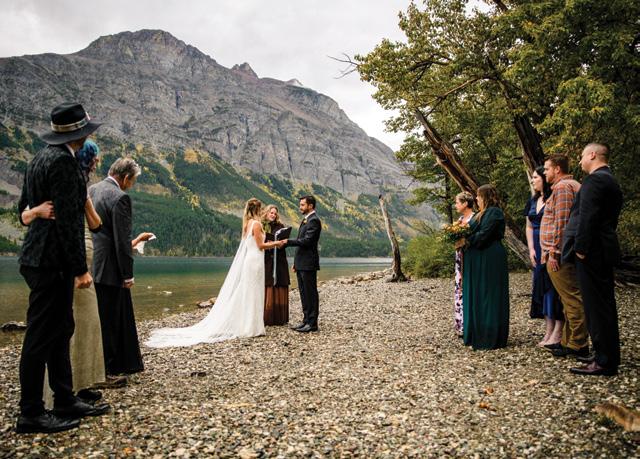
I knew I wanted to get married to Stacie when at the end of our dates we would just sit in the car, talk, and just stare at each other for hours before we parted ways. I never wanted her to leave and whenever we were doing our own thing, I just found myself always thinking about her and wanting to be with her every day of my life.

I never wanted her to leave and whenever we were doing our own thing, I just found myself always thinking about her and wanting to be with her every day of my life.
Itwas important to us to be able to take time with each other on our wedding day.
We wanted to remember every minute.
Why did you choose the venue you did to getting married?
When planning our wedding we knew we wanted to do something non-traditional. We wanted to get married in an epic-ly beautiful location in the mountains. We chose Glacier National Park specifically because it was # 1 on our list of places to go in the states and it did not disappoint. On our wedding day, it took almost 2 hours to drive to the ceremo ny site. Adam and I drove together with our family, photographer, and officiant in cara van. We had our ceremony, then family pho tos and a toast and then Adam and I left the group with our photographer until sunset. Adam and I spent the remainder of the day with each other and got to cherish being to gether. We had our reception dinner the fol lowing day. It was important to us to be able to take time with each other on our wedding day. We wanted to remember every minute.

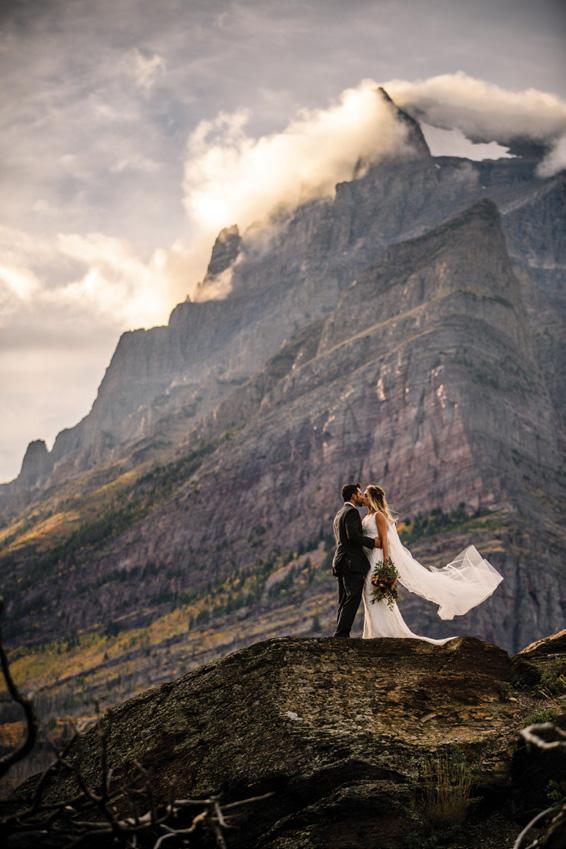
Stacie: What did you enjoy most during your wedding day?
I enjoyed being in an incredibly beautiful place with the most meaningful people in my life. As we are all adults and parents re tired, we don’t have many opportunities to travel together. Life is busy. Even though it down poured during our ceremony and made things a little chaotic at first, it didn’t matter. It was so special to have everyone there to celebrate with us. And I got to wear a pretty dress.
Adam: What is your favorite activity to do as a couple?
My favorite activity as a couple would be mountain biking. I’ve always enjoyed moun tain biking by myself and with friends so to have my best friend out on a mountain bike with me in the woods must be one of my fa vorite activities. She was nervous at first but over time I have seen her progress and gain confidence while on the bike and I can’t help
but smile when I see her riding through the woods with me.
Photography: Carrie Ann Photography
Venue: St. Mary Lakeshore, Glacier National Park
Caterer: Reception Dinner at Whitefish Lake Restaurant
Cake/Dessert: Fleur Bake Shop, Whitefish
Officiant: Sarah Harding
Music: The sounds of mother nature
Dress: Anna Campbell
Flowers: Mum’s Flowers, Whitefish
Makeup & Hair: Covet Beauty, Whitefish
Tuxes/Suits: Men’s Wearhouse
Rings: Bride - Moissanite Co
Groom - Ideal Jewelers, Inc, Litchfield, CT
Adam had his ring custom made with gold melted from his father’s, grandfather’s, and grandmother’s jewelry


























Betsi Morrison is a whirlwind of move ment and excitement when we meet. She sings out a greeting and quickly moves us away from the auditorium. She is running through rehearsals of SpongeBob the Mu sical during the time of this interview and suggests we go somewhere quieter. The musical’s energy has spilled out into the normally quiet theatre lobby, with adults helping kids rehearse lines and fix cos tumes. A quick “Let’s go up here!” And she is jogging up the stairs that lead to an empty sound booth. I admire her almost palpable enthusiasm. The warmth and magnetism she radiates doesn’t command or convince you to follow, but you want to be there anyway because you want to be in that presence. I’m sure that’s how she naturally is but being the Founder and Ar tistic Director of the Alpine Theatre Project (ATP) must help.
There are few artistic communities as prominent in the Flathead Valley as ATP. The professional the atre company that presents high-quality produc tions for both adults and kids as well as theatre education has been alive and well for 18 years and for all of them, Betsi moves in the center as its burning heart.

For her, the calling came early in life. “When I was a little girl, my parents and I would go to these traveling lounge acts that played at the old Viking Lodge,” She reminisced. “And I just loved to sing.” These acts were so special that when she was just three years old, she learned the song Delta Dawn off the radio so she could be invited onto the stage to sing with the popular lounge singer and family friend Dick Fisher. “From that moment on, I knew, I just knew.”
Her family later moved to Missoula where she joined the brand new Missoula Children’s Theatre and fell head over heels in love. “It was one of those things that was otherworldly, or spiritual, or past life, like when you know from a very young age there is no other option and it’s the only thing you want to do. I’ve always felt that way about the arts and performing.”
When Betsi grew up, she and her passion burned East, determined to make her mark on Broadway. Months within her big move she was landing roles in shows such as The Sound of Music and South Pa cific. It was there she also met the love of her life, another successful Broadway actor Luke Walrath. For a while, it was the two of them, working hard and living the life of their dreams. “Eight shows a week,” she remembers with fondness. “There wasn’t a day I didn’t come out my stage door and say ‘I did it. I’m on Broadway.’”
Then, on September 11th, 2001, their world stopped. As New York City tried to put itself back together, Betsi and Luke realized they needed to step away from everything. The best way to do that was to go to Montana, where her family was. They figured it was only going to be for a summer, to recharge and recenter themselves. Then migrate back to a city, as working actors do. But as with most things in Montana and its humble gravitas, it was not the case. As the summer went, Betsi and Luke realized this is where they needed to be. They both got jobs and Betsi went back to school, both contemplating what to do next. It wasn’t long after that, they were contacted by the renowned White fish Theatre Company to help take part in a new
theatre production to take place during the summer. Most people are busy enjoying the outdoors during the warm days and it’s dif ficult to get them inside. However, they all believed they could make it happen.


The production was a hit, selling out mul tiple shows. Afterward they thought about how much they enjoyed putting on the production, and decided they wanted to create a company of their own. There they reached out to actor and good friend David Ackroyd about their ideas, and the Alpine Theatre Project was born.
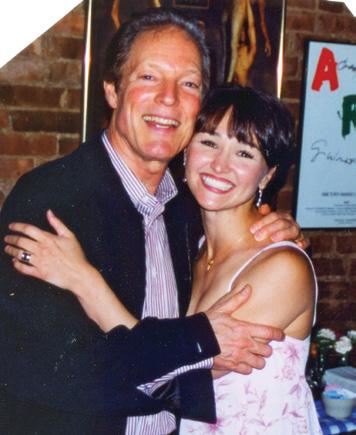
For the first five years after that, the three of them were one. “It was just all hands on deck, we were all doing anything we could to make it work, we were all shar ing titles, we were all just trying to learn. A steep learning curve!” But as more and more people began to arrive in Whitefish and make it their own, they saw the great potential of what ATP could be and made sure it had the support it needed. Eventu ally everyone began to settle in their roles, with Luke as Director of Development and Marketing and David was Head of Drama turgical Practices, and Betsi became the Artistic Director.
For those years, ATP was mostly an adult’s game. Betsi would host auditions for thou sands of actors, designers and technicians from all over the country to give them a chance to come to Montana and perform in the humble theatres of Whitefish and,
like so many before them, a chance to fall in love with Montana. Then in 2008, they changed everything by creating ATP Kids.
“At first it was just a chance to give back to the community that supported us so much in a way that was tangible, to use our pro fessional artists and teach theatre to kids” claims Betsi. “But then it became such a huge part of what we do. Being able to change the lives of young people is so awe some. In all ways being able to work with and hopefully mentor or shape a child is so fun and rewarding. It very quickly grabbed our hearts.”
The Alpine Theatre Project only grew from there, adding on classes to the busy sea sons of productions. In those later years, David Ackroyd retired from his positions and they hired acting Production Manager Rachel Burke. Betsi called Rachel her “right hand girl. She makes so much go round.” In those later years, Betsi and Luke welcomed twin boys into the world. “It was not in our life plan, but I cannot believe that I almost missed that opportunity, because being a mommy and a parent is the most incred ible and life altering thing I could imagine.”
ATP continued to influence the Flathead, and Betsi continued to burn.
Then, in March 2020, this time the whole world stopped. Betsi and ATP Kids were prepping for the first rehearsal of a high school production of Young Frankenstein
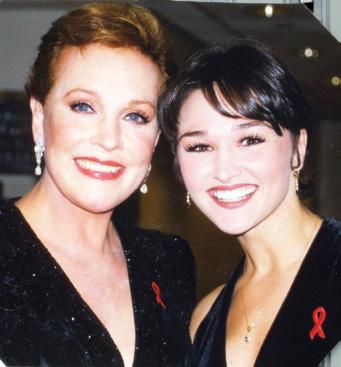
Photos from left to right: The Founding members of ATP, Betsi Morrison, David Ackroyd, and Luke Walrath, with Olympia Dukakis and Louis Zorich. - Performing with Julie Andrews in PBS's My Favorite Broadway: The Leading Ladies at Carnegie Hall. - Performing with Richard Chamberlain in South of Music on Broadway. - Performing with Robert Goulet in Rodgers and Hammerstein's South Pacific. - Betsi skiing with her twin boys Gabriel and Elijah.

“It was an example of the will of the human spirit. We’re all in this together, it’s one of those moments where everybody bonds together.”

when the Pandemic hit. The impact was harsh for everyone, but in an in dustry that so heavily relies on human connection, it was devastating. But Morrison knew she couldn’t give up. “I had a very specific strategy to not stop. I was not going to shut down.” She chose to keep moving, to keep burn ing. To make sure the show went on. She bought green screen supplies and their costumes and shipped them to her students. She directed them where to look and when, to dub their singing over their videos and how to fully edit videos so the musical could come together in one smooth production. The production garnered attention from American Theatre Magazine. She didn’t stop there. The younger children’s production was performed in the parking lot where audiences sat in cars. The children were bundled and hooked up to radio transmitters so parents could tune into them from their car stereos and honked for applause.
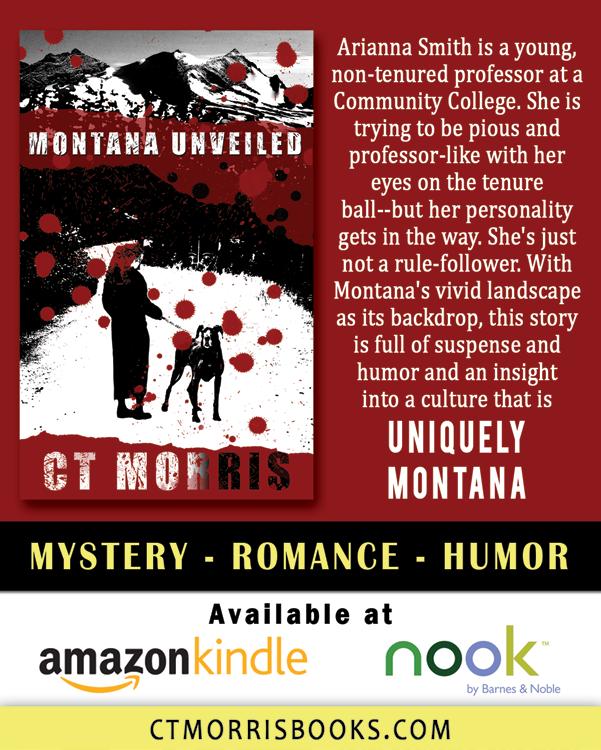
For the adult productions, Betsi decided to have the performance in the woods. She brought aerialist Marcy Richardson to perform Operalesque, the audience would sit and watch the performance socially distancing in the trees.
“It was an example of the will of the human spirit. We’re all in this together, it’s one of those moments where everybody bonds together.” All of the pro ductions were a success, in spite of it all.
When she’s not at the theatre, Betsi can be found in the mountains. Whether it’s to decompress after a busy day, or to gain inspiration for the next new thing, she’s always taking advantage of the Montana wil derness. “Running a nonprofit theatre can be quite stressful; It’s crucial for me as a creative person so I'm not consumed.”
Betsi and I are sitting in the sound booth overlooking the Whitefish Middle School auditorium. During the week of my interview, the SpongeBob rehears als are in full swing and the performance just days away. There’s a myriad of colors on stage and kids are running about readying for the next song, being shown where to stand, when and for how long. It’s hard not to lean over switches and buttons to watch them fine tune their performances. One actor in particular is one of Betsi’s sons, belting his solo into the rafters. She’s grinning from ear to ear as she shifts to get a better look; it’s a moment of life coming full circle for her and she’s bursting with happiness. Soon, Betsi will be moving into rehearsals with the adults for upcoming shows including the fundraising holiday special, Yuletide Affair 19. But for now, she sits and watches, proud of what occurred and excited for what’s to come.

To see a performance, become a member, or support ATP, visit atpwhitefish.org.



I learned to ski when I was a little girl. It was something that we started as a family all at once. My parents stepped into their first skis in their mid 40’s and as I inch towards the age that they picked up the sport, the more impressed I get with them. Often as we get older we use age as a limitation or a reason not to pursue new interests and experiences. I was talking with another friend and I asked if she was go ing to ski this year and she said she was “too old.” This beautiful mother of three is years younger than me and younger than my mother was when she started. As I talked with Mag dalen (Mags) Shale, the Snowsports & Summer Activities Director at Whitefish Mountain Re sort, I relayed this experience. She expressed her sadness that people think that “youth is a prerequisite to the sport.” Mags sees this as a lifetime sport, one that you can do when you are little and also when you are “too old.”
Mags started her ski career in racing and free style in the Canadian Rockies. In her youth, she experienced an injury and in that time during recovery, she was able to examine other avenues to develop into a career. She started working in the ski school at her local mountain and attended school obtaining an educational degree in the Montessori educa tional system. Early in her career, she was able to spend a few years in a skier's dream of 300 days on her skis by alternating time between Canada and Australia. Mags is most recently from Jackson Hole where she worked for 20 years until an opportunity opened at a childhood favorite resort. Over the years, Mags added skills to her continuing educa tion, making sure she stayed up-to-date and relevant to the changing industry. This new opportunity combined her experience with ski education, training, team development,
and certification in Mountain Bike instruc tion and Rope Courses. Her love of education, continual learning, and training brought her closer to home and to a community she loves.
I asked Mags if she felt her education with Montessori was helpful in her career. As you can imagine, she said yes, and continued with reasons that no doubt make her successful in her career. Mags understands and fosters an effective form of teaching on the mountain and makes education a priority. Adaptive teaching is key when addressing a new skier or one that has been skiing for years. Looking for social cues and that moment of readiness to take the next step. The moment of readi ness is when the puzzle pieces are coming together and you can see a skill or theory click in the student. It doesn’t look the same for everyone so reading and understanding
people is a big part of the job. Her passion is clear, and she wants to be part of the pro cess in which she can watch someone grow, can mentor, and create leadership in not only ski students but those that are in her team on the mountain.

The Whitefish Mountain Resort Ski School team is composed of about 150 instructors in a season. Instructors come from all over the world and have a wide range of skills. The diversity of the team allows for every student to gain additional experience and knowledge no matter the skill level.
Year after year, ski technology changes and evolves. Some feel left behind with that or unable to figure out the new techniques that
will make their experience with new equipment more enjoyable. Lessons can bridge that gap and give confidence in us ing new equipment.
As we age, our body changes and so does our physicality. Since skiing and snow boarding are lifelong sports; lessons taken throughout your life are perfect to adjust to the changing body. How you learned to ski when you were eight years old is not how you should ski when you are 18, 38, 58, or 78. Your center of gravity and ath leticism change. Not only will you learn new techniques, but you will also learn how to mitigate potential injuries.
Advanced skiers are great students to have on the mountain. You may think that if they are advanced, what can a les son do for them? The biggest thing that lessons can do, is help you see the moun tain differently. Often we have the same lines and places we like to go. Going with someone new can help you experience more. An advanced lesson can train you in mountain and terrain tactics, mountain survival, spotting danger zones on expert terrain, and trying out new equipment.
All these lesson reasons are why skiing and snowboarding are lifelong sports. There is always something new for you to learn and experience. It’s also a sport that offers something to the entire family. It is a vehicle for fam ily engagement. Everyone can take a few runs together, even with differing skill levels, and find enjoyment.
The main focus Whitefish Mountain Resort wants to create is a positive experience for each person who steps foot on that mountain. Lessons and time with their guests help them create those experiences. It al lows them to address concerns, increase guest safety, improve skills, and create a community of skiers finding a home on the mountain. This is a family resort in a beautiful community and each member of the team is excited to help you and your family experience more of the mountain.
Take advantage of this curated team of professionals like Mags. Remove limitations or insecurities that could be holding you back from experiencing all the mountain and the world of skiing has to offer. Whitefish Mountain Resort has a world-class team on a world-class mountain just waiting for you to experience.



r emove limitations or insecurities that could be holding you back from experiencing all the mountain and the world of skiing has to offer. Whitefish Mountain r esort has a worldclass team on a world-class mountain just waiting for you to experience.
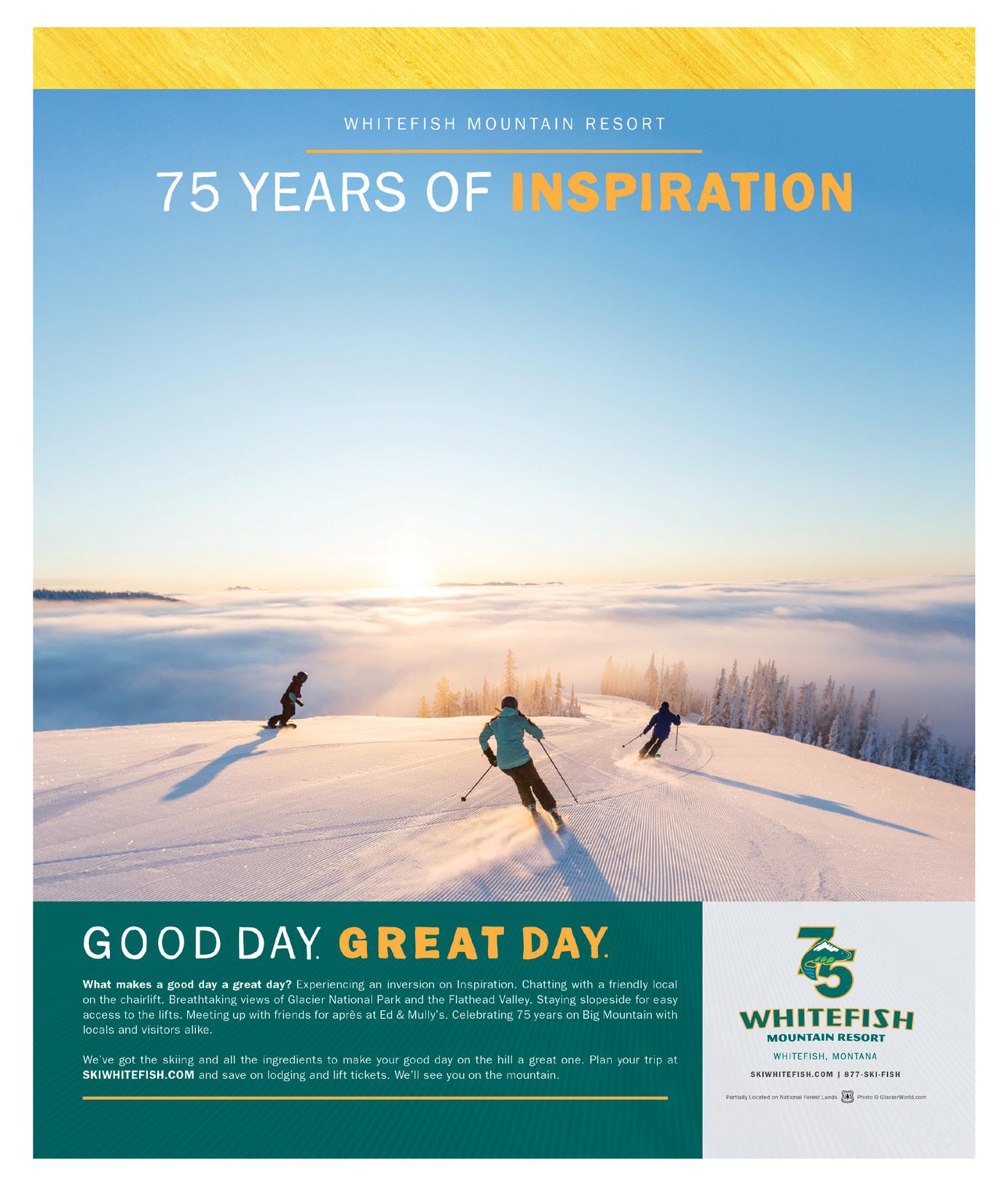



My wife and I love outdoor activities and this area is a great place to raise a family. We enjoy the sense of community and getting to know the community.
I am board certified in general and cardiothoracic surgery. Over the last few years I have refined my skills in minimally invasive surgery and most of the operations are performed robotically. Currently my scope of practice covers any chest pa thology including lung surgery, benign and malignant esophageal surgery among others surgeries in the chest.
I went to medical school in Monterrey, Mexico which provided me great exposure to private and socialized medical care. I then spent some time at the Texas Medical Center doing research in cardiac surgery. I completed my general and cardiotho racic surgery training in New York including robotic surgery.

The best part of taking care of cancer patients is to participate in the entire pro cess and see the whole story, from the disheartening moment they discover a can cer diagnosis, to conducting an often curative operation and following patients years after surgery during their surveillance. Many patients have a very different approach to life after such an experience and I am blessed to be part of that.
Thoracic surgery is one of the most versatile specialties. I have particular interest in cutting edge technology such as robotic sur gery, navigational bronchoscopy and single incision surgery.


Lung surgery is the majority of my practice. I also perform surgeries in the esophagus; however, my scope of practice is very broad and in cludes surgery for reflux disease, thoracic outlet syndrome, surgery for diaphragmatic problems, chest wall reconstruction surgery and complex bronchoscopy and endoscopic procedures to mention few.
Medicine is an evolving field, you see so many innovations that can be overwhelming at times. In terms of surgery the technology with robotic surgery and minimally invasive techniques are very impres sive, however outside the OR we have seen the treatment of cancer change drastically. Radiation oncology, radiofrequency ablation and immunotherapy are just some of the innovations we see on regular basis.
My wife and I love the outdoors and traveling. My favorite sport is probably rock climbing but we also love snowboarding, kayaking, camping, cycling and sailing. I plan to get back into horseback riding now that we are in Montana. We enjoy cooking and obviously time with our kids. We also have a rather wild dog who keeps us enter tained.


head Valley is a hotbed for thrill seekers of all kinds. Every year, adventurists such as climbers, whitewater rafters, mountain bikers, skiers and snowboarders take to the mountains, lakes, rivers and trails to feel the adrenaline rush that they crave. But with every adventure comes great risk. For 70-year-old Larry Bruce of White fish, an avid climber, biker and all-around outdoorsman, the risk of adventure is what may have saved his life.
Back in September 2021, Larry and his wife Molly, were biking the trails of Spen cer Mountain in Whitefish, a trail they have biked countless times during their 33 years in the Valley. But on that day, fate had a dif ferent plan for the Bruces. “I don’t remem ber why, but I ended up getting off course,” recalls Larry. The unfamiliar terrain resulted in a nasty wipeout for Larry. “I was toma hawked off my bike and ended up knocking myself out,” says Larry. “When I came to, I had signs of amnesia, but I seemed to be for the most part alright.”

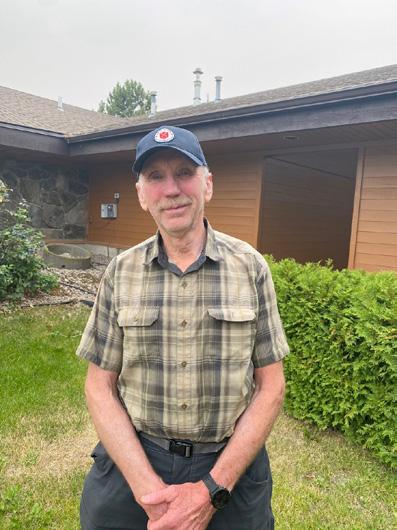
that no medical attention was necessary. But Molly was not taking any chances. At the time, Larry had been on blood thinners due to issues with atrial flutter. Molly deter mined that a head injury with those condi tions was dangerous and told him to get to the emergency room.
Larry paid a visit to the emergency room at Logan Health - Whitefish and was looked over by an emergency physician. She and her team did a thorough evaluation and, while they determined that his head was fine, they found some concerning lesions on his pan creas and a nodule on his lung. Larry’s care team determined that the best move would be to have a biopsy done on both to make sure they weren’t anything more concerning.
While the lesions on the pancreas checked out fine with the gastroenterologists at Lo gan Health Digestive Center, the lung nodule was determined to be cancerous. The good news, however, was that the cancer was caught very early and could be addressed with minimally invasive surgery and there fore, he would be able to recover fully. “It’s
could have potentially saved my life,” con tinues Larry. “But if that thing would have
Larry was referred to Dr. Luis Alberton, thoracic surgeon at Lo gan Health Medical Center. Dr. Alberton, one of the region’s most refined minimally invasive surgeons, assured Larry that robotic surgery would be the least invasive approach and would likely have a shorter recovery time. An avid outdoors man himself, Dr. Alberton understood the importance of a short recovery time for a person like Larry. Minimally invasive robotic surgery expedites a patient’s recovery time by avoid ing the chest wall trauma that would’ve been necessary for a more traditional thoracotomy.

In January 2022, three months after the bike accident, Dr. Alber ton performed a robotic lobectomy on Larry in which he removed about a quarter of his lung. Just two weeks after the procedure, Larry was able to resume some activities. And by the following summer, he was back biking Spencer Mountain. “I’m glad that I had somebody like Dr. Alberton taking care of me,” says Larry. “Tho racic surgery is a nice thing to have available in our community.”

Today, Larry is cancer free and continues to improve. Although his aerobic threshold has been compromised with the removal of part of his lung, he continues to push the boundaries that have been set for him. While a fluke accident led to the discovery of Larry’s can cer, it’s important to have regular screening — such as lung cancer screening —at the appropriate ages. To find out more about the proper screenings you should be having at your age, talk with a primary care provider today!
Larry was able to get back to doing what he loves thanks largely in part to Logan Health’s system approach. With a flagship medi cal center in Kalispell complete with numerous specialty clinics and providers, Logan Health’s critical access hospital in Larry’s hometown of Whitefish was able to connect him with the proper specialists he needed to see in a timely manner.



Early detection and prompt treatment can turn a breast cancer sufferer into a breast cancer

survivor. Various organizations, such as The American Cancer Society, The American College of Obstetricians and Gynecologists, and the US Preventative Task Force to name a few, have developed guidelines for how best to screen average risk women for breast cancer based on age. The guidelines vary slightly but generally agree that breast cancer screening should begin at age 40 and occur every 1-2 years. Informed decision making between pa tient and provider should guide the details of frequency and when to stop screening.
Mammography is the gold standard for most accurately detecting breast cancer over all other imaging modalities. For this reason im aging centers do not offer ultrasound, also known as sonography, or magnetic resonance imaging (MRI) as a substitute for mammo grams. Ultrasound, MRI or thermography may be used as an adjunct to mammograms, how ever. Thermograms show heat patterns that may indicate cancerous changes, but the FDA does not endorse use of thermography alone to detect early-stage breast cancer as accord ing to the FDA acceptable scientific evidence is lacking for accuracy.
Still a very large portion of breast cancers are initially detected by the person with the can cer, so self-breast awareness is very impor tant. Pay attention while bathing or dressing to changes in the contour or appearance of the breasts as well as to their texture. Report
any bulges, dimpling, thickening, lumps, skin or nipple changes, nipple discharge, or new asymmetry to your care provider promptly. It is common for one breast to be larger than the other unless perhaps this is a change for you.
Once a breast change is noticed, you can expect your care provider to order a diagnostic rather than screening mammogram often along with an ultrasound. The mammogram detects den sities and patterns of densities through x-ray while the ultrasound defines fluid vs. solid characteristics through sound waves. If the ap pearance of the abnormal area then warrants correlation with the microscopic characteris tics of the cells at that location, a biopsy will be recommended.
A diagnostic mammogram differs from a screening mammogram in that it is more tar geted at the site of abnormality. Although the cost and insurance coverage of each are likely
to be different, it is not appropriate to substi tute a screening mammogram for a diagnostic mammogram when a breast change has been identified since the screening mammogram does not evaluate the abnormality to the ex tent that the diagnostic mammogram does.
Additionally, when a suspicious site is identi fied on a screening mammogram, diagnostic imaging is employed to gather more detailed information about the site in question. Most suspicious sites found on screening mam mograms are determined to be benign upon diagnostic imaging. It is not uncommon to be called back for further imaging after a screening mammogram, particularly if it is your first mammogram. The first mammo gram serves as a baseline to which subse quent mammograms are compared.
a very large portion of breast cancers are initially detected by the person with the cancer, so self-breast awareness is very important. Pay attention while bathing or dressing to changes in the contour or appearance of the breasts as well as to their texture.
Do not be afraid to share breast concerns with your health care provider, who can address the safety of breast screening modali ties or your preferences. A good time to discuss this is at an annual clinical exam. However, if you notice a breast change, do not wait for an evaluation. Schedule a breast exam even if you are not due for an annual exam. In the end you are the best steward of your health care needs.
Financial programs such as Montana Cancer Screening Program and Save a Sister are available in Flathead County to assist with the cost of screening mammograms or additional studies. Your health care provider can refer you to either of these programs, or you can con tact The Montana Cancer Screening Program at 406-751-8162 or enroll to see if you qualify for assistance through their website at https://flathead.mt.gov/. Other resources for information on breast cancer and breast cancer screening for the general public can be found through The North American Menopause Society at https:// www.menopause.org/for-women, The American Cancer Society at https://www.cancer.org/cancer/breast-cancer.html, or The Ameri can College of Obstetricians and Gynecologists at https://www.acog. org/. For more information Shawn Shanahan, APRN-WHNP has 35 years as a Women’s Health Nurse Practitioner and can be reached at Kalispell OB-GYN at the Falls at 406-752-5252.
Shawn Shanahan, APRN-WHNP-BC, RDMS, WHE
Shawn Shanahan, APRN-WHNP-BC joined Kalispell OB/GYN in March 2021, moving to Montana in 1986 to raise her two sons and to enjoy the great outdoors with her spouse. She earned her nursing degree from the University of Utah in 1986. She became a Women’s Health Nurse Practitioner through Harbor-UCLA in 1987 and earned her Master of Science in Nursing through the University of Nevada – Reno in 1993.

Shawn received the Award for Innovations in Health while at the University of Utah and served many years in various board roles of professional organizations such as the Montana Nurses Association and the Montana Advanced Practice Registered Nurse Association and as a Montana State Family Planning Medical Advisory Committee member. She taught nursing at Northern Nevada Com munity College and Salish Kootenai College.

Shawn has 10 years of public health experience in addition to over 25 years of private practice. She is also a Registered Diagnostic Medical Sonogra pher (RDMS) and a certified Wholistic Health Educator (WHE). Shawn enjoys providing a wide range of women’s care including contra ception, fertility care, menopause management, prenatal and postnatal care, sexually transmitted disease management, bladder care, cancer screen ing, and management of sexual concerns.
Shawn seeks to empower patients and their fam ilies through education to pursue informed choices that promote well-being.


tween
 By Terri Lynn Mattson for the Northwest Montana History Museum
By Terri Lynn Mattson for the Northwest Montana History Museum
The year is 1923. Children are returning home from a long day at the ponds in Woodland Park, wet laces tied together on their skates, tossed around their shoulders. It is Saturday. Tomorrow, families will attend church with languag es from English to Latin to Norwegian (all depending on which denomination they’re part of). The 9 a.m. Low Mass at St. Matthew’s will be largely quiet, reverent, and part of the continuation of a tradition centuries old. Scandina vian Lutheran services—soon to transition with the generations of immigrants from Norwegian language services to English—continue traditions from the homelands of Denmark, Sweden, and Norway. Other congregations will cel ebrate their church services with many modern hymns, with Christianized lyr ics put to the classical tunes of the last four centuries. The children will attend church—as always—with their parents in whichever practice of Christianity they adhere to. It is December 22—two days before Christmas Eve.
Kalispell, founded only in 1892, already had a vast number of churches in all different denominations by 1900—to say nothing of its composition almost a quarter century later. In one of the first religious data censuses (in November of 1898), Kalispell (exclud ing saloons, hotels, sporting quarters, and the Chinese quarter) consisted of a largely Methodist, Presbyterian, and Episcopal Christian community. The Methodists had a wider-reaching impact on the valley. The found ing of Lakeside was the result of the Methodist com munity obtaining a tract of land on Flathead Lake. The intention of the community was that the land would be used for their religious and educational programs. This tradition has continued with various Christian groups, through the establishment of bible camps of almost ev ery denomination on the shores of Flathead Lake that exist today in 2022. By May of 1913, these numbers had shifted slightly, however, with Methodist and Presbyte rian still the larger congregations in Kalispell, but with a large uptick in the Lutheran community—due to the increase in Scandinavian and German immigrants to Ka lispell since the previous census.
One of the early Kalispell celebrations, the 1923 Community Christmas Tree on Main Street stood lit between 1st and 2nd streets from December 23 to a week after Christmas (January 1, 1924). Children were encouraged to the event to dress warmly for the initial lighting and a visit from Santa Claus. (From the Northwest Montana History Museum collections.)
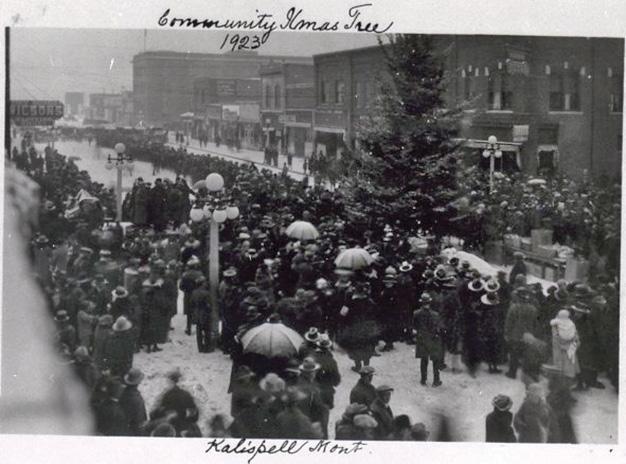
As with other community buildings and businesses in Kalispell, many of the early churches in town (the larger ones still in operation today) have been around since the platting of the city, but in a very different form than they stood even two decades later. Starting with wooden buildings located further abroad of Main Street, by 1920, a few of the more firmly-established Christian communities had finally built their permanent brick structures closer to Main Street. Bethlehem Lutheran was organized in 1895 under
the name NorwegianEvangelical Lutheran and built in 1897 on 5th Ave W and 4th St. The congregation re located to the present structure in 1932. St. Matthew’s parish was established in Kalispell in 1894 with the first frame building built at 4th Ave E and 5th St. The new (and present) St. Matthew’s church building was completed in 1910. Methodism in Kalispell started with the establishment of the Methodist Episcopal church in Demersville*, built in 1891. The Kalispell Methodist church was built in 1894. One of the other churches on Main Street, close by the old County Courthouse, is First Presbyterian. With the Presbyterians largely located in Ashley** prior to Kalispell’s found ing, it was in August of 1891 that the First Presbyterian church of Kalispell was orga nized. The modern Presbyterian Church took an extensive amount of time to plan and build. It was finally dedicated in April of 1927— eleven years after the lot was purchased in 1916.
While many of these churches were still in their early stages and even working on plans for their more permanent buildings, these congregations served as the strong moral and community centers of Kalispell. Regardless of theological differences, the small, young com munity of Kalispell came together to put com munity celebration at the center of the Christ mas festivities. Just days prior to December 22, 1923, the Daily Inter Lake released the plans of various “community Christmas tree committees” in their joint planning to pro duce, for young and old alike, a display on Main Street of a lit Christmas tree. The De cember 19 initial announcement didn’t give any indicator as to where these committees
The collage contains photos of the early church es of Kalispell. The top row shows Trinity Lu theran Church and Westside Methodist Church. The center church is Christ Church Episcopal, and the bottom row of churches are the original building of St. Matthew’s parish and First Bap tist Church. (From the Northwest Montana His tory Museum collections.)
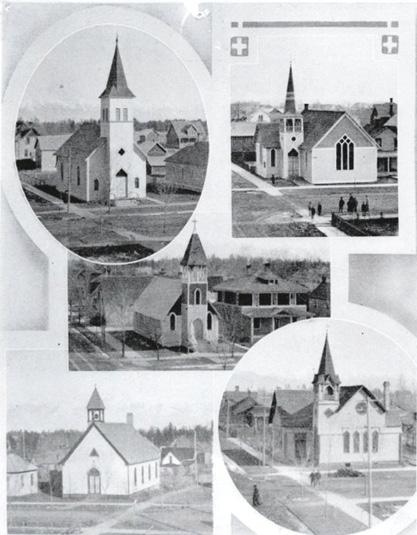
heralded from or whether their members even all belonged to the same congregation. “Various” choirs are listed to lead the celebra tions scheduled for the next day (Sunday, De cember 23).

On Friday, December 21, a more detailed ar ticle was released by the Daily Inter Lake. The Christmas Tree committee is named as a sin gle entity, still likely to have been made up of members of various congregations across the city. The Flathead County Band of Kalispell is enlisted to play Christmas songs, and commu nity singing is slated to be led by “the church choirs” and all attendees to the event. The mu sic selections are all religious and not secular (as many of these numbers weren’t written yet in 1923), clearly indicating that regardless of denomination (or even lack of Christian ity), Christmas was held by the community as a religious celebration. It was a celebration that brought the whole community together in the hours following Sunday church services and Masses. While the basis may have been a religious celebration, it was also a commu nity celebration—one that brought people together in a joyous occasion that held the small community together in one moment of shared greater purpose and common mission, regardless of the smaller divisions within it.
*A city unlike any other at its time, Demersville was once the premier destination in the Flat head Valley. The once-active community is now a deserted stretch of rural road.
**Ashley, now part of Kalispell, is a former set tlement that many place where Meridian Road crosses Ashley Creek.
While many of these churches were still in their early stages and even working on plans for their more permanent buildings, these congregations served as the strong moral and community centers of Kalispell.
At 53 years old, Gina searched for a binky while bouncing her fussy 2-month-old daughter on her hip. Around her, framed pictures of all three of her babies, all under three years old, covered every wall.

“As soon as they come through that door, they’re family,” Gina said of her three girls.
When deciding to become foster parents, Gina and her husband as sumed they would be a temporary family for children until their par ents could provide a safe, stable home for them again. They would love them like their own while they could and then embrace the bit tersweetness of reunification when the time came.
Baby Lilah was less than 24 hours old when Gina brought her home, her first placement. Right away, Gina had professional photos taken and made a baby book to give to Lilah’s birth par ents.
“They’re already stuck in a hard place,” she said. “They needed to know in their hearts that their baby was okay.”

In Gina’s eyes, having something so precious taken away would only add fuel to the fire of the addiction that was forcing them to miss out on their child’s life.
She sent the book and a few little gifts to Lilah’s parents. Soon after, Gina got a call. Lilah’s birth parents were elated and wanted to meet the woman behind such unexpected acts of kindness.
At their first meeting, Gina made the couple a promise.
“We will always take care of your baby,” she told them.
As her relationship with Lilah’s par ents deepened, Gina realized just how firm of a hold drugs truly had on them. They missed scheduled visits without explanation. Their home had no running water. And they were no closer to kicking their addiction than when Lilah was born.
Then one day the phone rang. Lilah’s parents had decided to give Gina legal guardianship of Lilah, permanently.
“They told me, ‘We want to be in her life, but you’re her mom,’” Gina said. “To hear someone say I was their daughter’s moth er was heartbreaking.”
Not long after, Lilah’s biological mother gave birth to another little girl named Brixton. She too needed a home. Her parents asked for Gina.
In between the two sisters, Gina and her hus band had also taken in their cousin, Tai'la, who was not yet a year old. Lilah, Tai’la, and Brixton – three babies in one house.

“We know we’re getting older, but we still have enough life in us to raise these kids,” she said.
Had Gina not pursued her girls’ birth families, supporting and loving them as well as their children, all of their lives would look much different today. Their birth parents would likely still be struggling with an impossible situation – trying to keep a child safe and healthy despite their inability to take care of themselves.
Through it all, Gina has never wavered in her commitment to maintaining her relationship with her daughters’ biological families. De spite their addictions, she knows they still love their children even if they cannot care for them.
Because of Gina’s willingness to open her heart and her home, three little girls will get to grow up and look back at thousands of photos that show just how deeply they are loved.


There is a distinct need for more foster fami lies. Child Bridge is ready and able to answer any questions you may have about fostering Montana’s beautiful children. Visit childbridgemontana.org.


Child Bridge has been sharing amazing stories of love, hope, and compassion like Gina’s for many years within the pages of 406 Woman magazine. As this is the last “Changed Lives” column, we are grateful to have worked with the entire staff and wish them only the best as they continue to change the lives of Mon tana’s abused and neglected children. Thank you for all you do.
In Gina’s eyes, having something so precious taken away would only add fuel to the fire of the addiction that was forcing them to miss out on their child’s life.
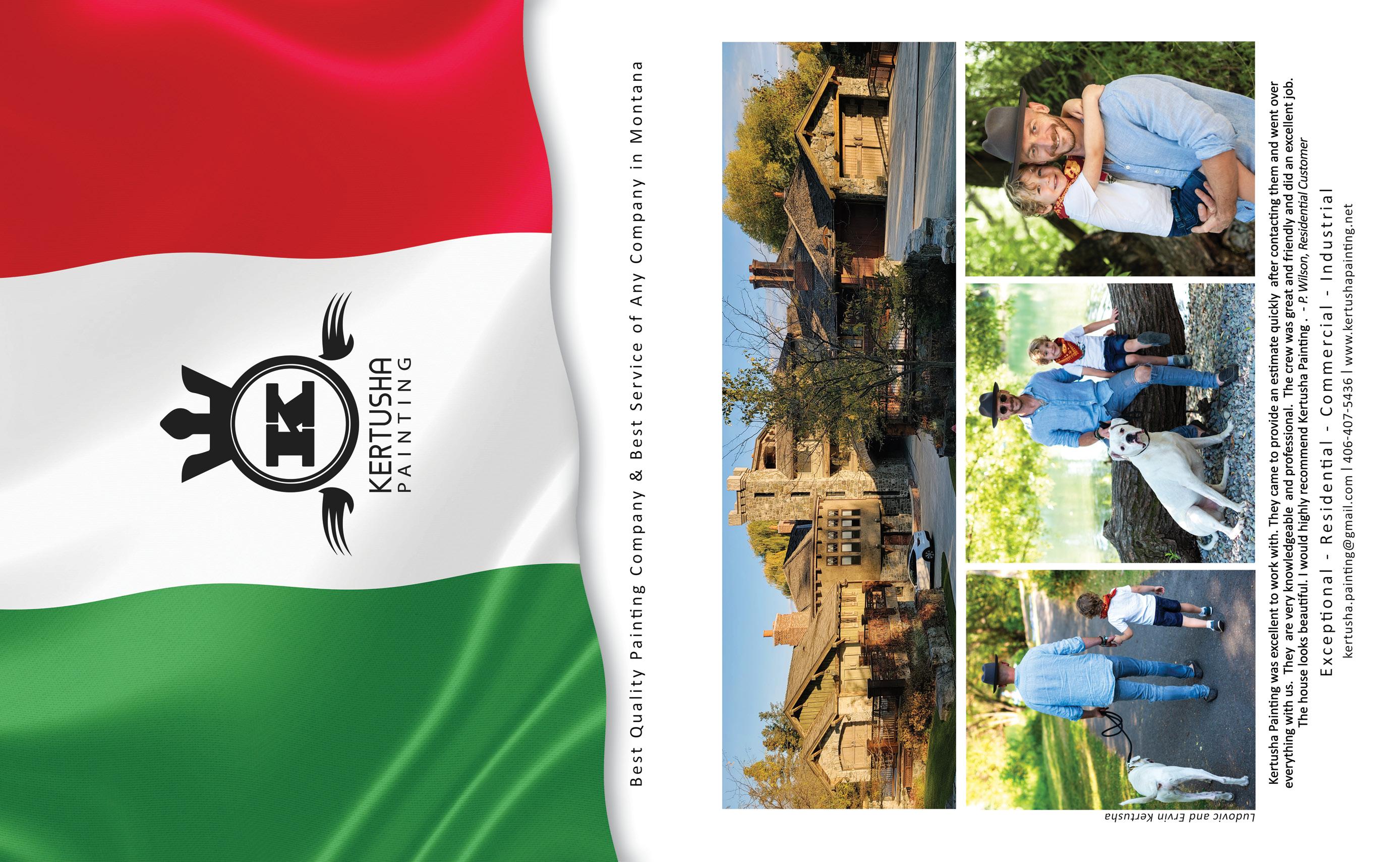

Eureka!! No, not our beloved little border town to the northwest, but the moment...the Eureka moment. Also known as the “Aha” moment, the Eureka moment is the common human experience of suddenly understanding a previously incomprehensible problem or concept. I might also add it’s the sudden understanding or discovery of something never before known to the discoverer.
I experienced a moment like this some years ago while I was studying dentistry in San Francisco. My wife and I are both small town kids from ru ral Alberta and rural Arizona respectively. So, to find ourselves living our daily lives amongst the iconic streets and architecture of San Francisco felt surreal to say the least.
It was there in 2010 amongst the cutting-edge tech companies of the bay area that we happened upon a device fabricating a figu rine before our very eyes. A cube approximately a square foot in di mension with clear glass on 3 of the vertical walls. A cube that said “MakerBot” on it. A cube that was printing in three dimensions.

The object being printed was crude, the process you could tell was novel and unrefined...barely out of beta. My wife was not overly im pressed, but inside my head I was having a Eureka moment. I could see the concept for its potential
and started spewing forth my predictions of the spaces this technology would ultimately invade and revolutionize. I very specifically said, “they will build houses like this one day.” Google it.
As I mentioned, this early version lacked preci sion. Or in industry terms it had a low resolution. Like a photo, or early computer graphics it was pixelated. Things were being measured in terms of millimeters. While that might sound small and precise, in the world of restorative dental ma terials we measure reso lution/precision in terms of micrometers, or thou sandths of a millimeter.
So at the time, in 2010, just as I had seen enor mous advancements in computer technology throughout my life, I knew that it was only a matter of time until
advancements in 3D printing tech reached an acceptable level of resolution for dental applica tions. It should come as no surprise, especially since I’m writing this article, that the time is now and it’s incredible.
Over the last decade, concurrent advance ments in 3D digital oral scanners, 3D Conebeam computed tomography systems (3D X-Rays much like an MRI), and 3D printing provide us an incredibly diverse toolkit when it comes to practicing dentistry. From simple applications like fabricating night-guards, athletic mouthguards, and even bleach trays that fit better than their analog versions. To complex digitally guided surgical procedures allowing a patient with no teeth to have a permanently retained implant bridge in the space of a few hours. All done with pin-point accuracy without the need for goopy impres sion material.

Digital planning and execution allow for dental procedures and surgeries to be done as minimally invasive as possible. There’s no guesswork. The surgery is planned digitally and surgical guides are 3D printed allowing the dentist to place the implant exactly where it needs to be. This was all done free-handed prior. I hope you can understand just how cool this is.
The type of 3D printing utilized by the industry leader in dental is a resin based DLP printing process. Unlike what you might think of or visualize when you think of 3D printing, this method uses a resin filled tub. This resin polymerizes (hardens) by exposure to light and then lifts out of the resin bath fully formed. It’s honestly something straight out of science fiction.




With this type of resin printing, we are only limited by the types of res ins being created. Within the past year alone several resins have been approved for permanent crown and filling applications and the results I'm seeing are incredible.

Get excited folks. This is a shift in dentistry. Just like digital scanning took about 20 years to fully take over with digital impressions, this is the future for a lot of dental’s common restorative and surgical procedures. It’s only going to get better and it’s all available at Smile Montana Dental Center.
As always, thank you so much for not only reading my article, but for making it to the end. You are in no doubt a lovely person with an incredible smile. I see you out there. Happy Holidays everyone. This winter is going to be great with spirits bright and powder plentiful.
Get excited folks. t his is a shift in dentistry.
Just like digital scanning took about 20 years to fully take over with digital impressions, this is the future for a lot of dental’s common restorative and surgical procedures.3D Printed Crown, courtesy of Dr. Wally Renee Digital implant planning on 3D X-Ray 3D Printed implant surgical Guide Implants being placed with Precision using the 3D printed surgical guide.